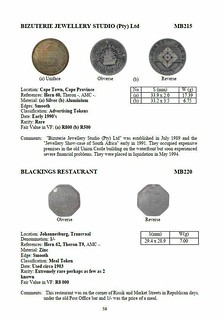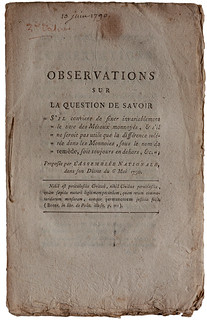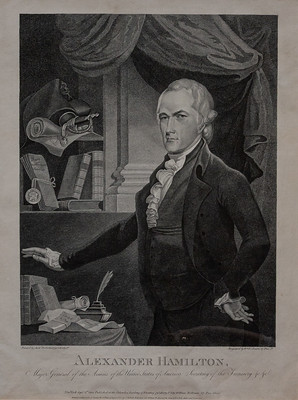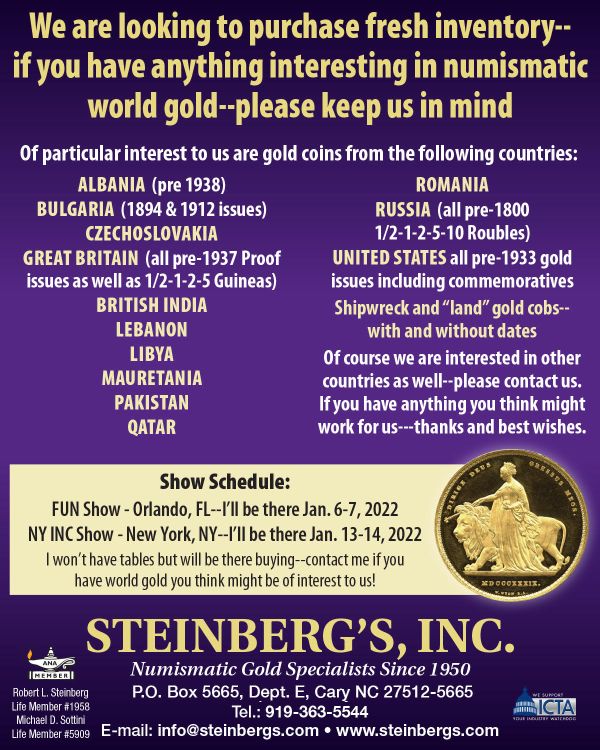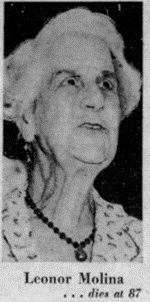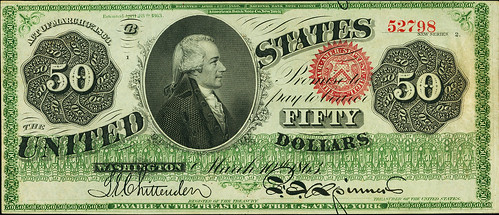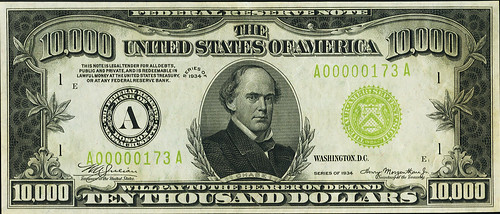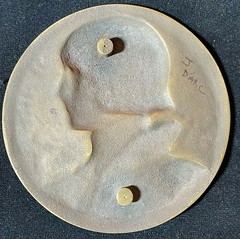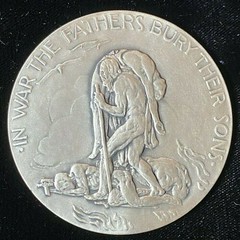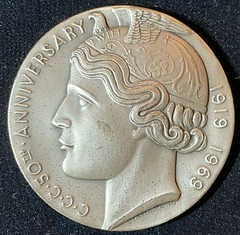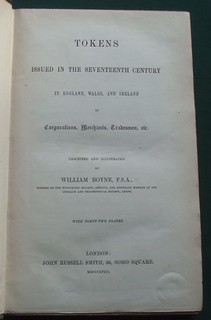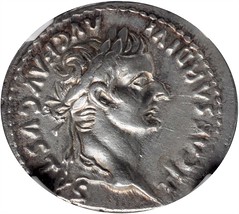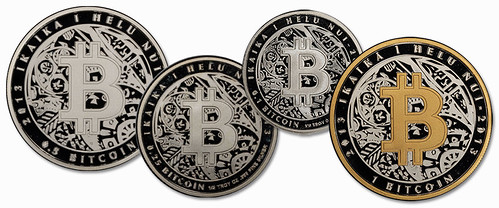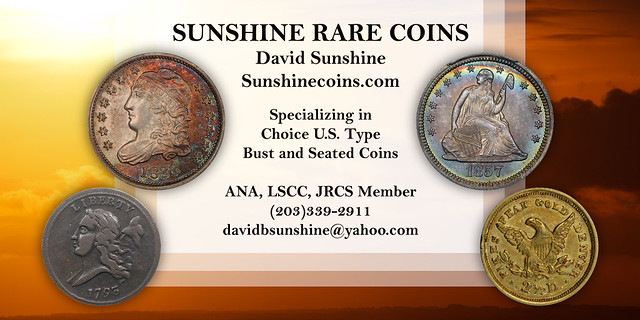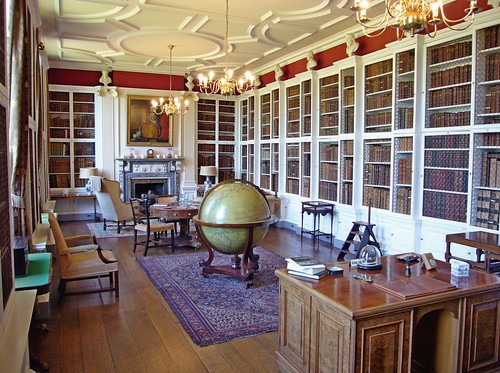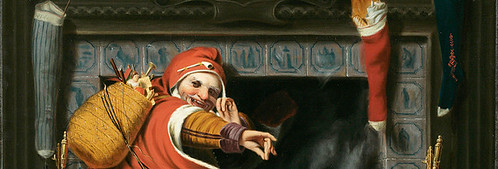
Visit our NBS Sponsors



About UsThe Numismatic Bibliomania Society is a non-profit association devoted to the study and enjoyment of numismatic literature. For more information please see our web site at coinbooks.org SubscriptionsThose wishing to become new E-Sylum subscribers (or wishing to Unsubscribe) can go to the following web page link MembershipThere is a membership application available on the web site Membership Application To join, print the application and return it with your check to the address printed on the application. Print/Digital membership is $40 to addresses in the U.S., and $60 elsewhere. A digital-only membership is available for $25. For those without web access, write to: Charles Heck, Treasurer AsylumFor Asylum mailing address changes and other membership questions, contact Chuck at this email address: treasurer@coinbooks.org SubmissionsTo submit items for publication in The E-Sylum, write to the Editor at this address: whomren@gmail.com BUY THE BOOK BEFORE THE COINSale CalendarWatch here for updates! |
- WAYNE'S WORDS: THE E-SYLUM DECEMBER 26, 2021
- NEW BOOK: ERRORS ON CANADIAN COINS, V2
- NEW BOOK: SOUTH AFRICA TOKENS
- NEW CHAPTERS: NEW ZEALAND MEDALS 1939-40, 2020S
- 2021 ANS LIBRARY & ARCHIVES ACQUISITIONS
- VICKEN YEGPARIAN COIN WORLD COLUMN DEBUTS
- KOENINGS' REEDED EDGE HALF NEWSLETTER
- VIDEO: COINS IN THE BIBLE
- FIRST U.S. NUMISMATIC SOCIETY?
- POTENTIAL A.N.A. 75-YEAR MEMBERS
- NOTES FROM E-SYLUM READERS: DECEMBER 26, 2021
- COIN FOUND IN LEE STATUE TIME CAPSULE
- VOCABULARY TERM: BUFFING AND POLISHING
- LEE F. HEWITT (1911-1987)
- REMEMBERING ROBERT LLOYD
- LEONOR MOLINA (1869-1957)
- THE FUTURE OF LIVE AUCTIONS
- HERITAGE 2022 FUN SALE PAPER MONEY HIGHLIGHTS
- WEXFORD EBAY MEDAL SELECTIONS DECEMBER 2021
- NUMISMATIC NUGGETS: DECEMBER 26, 2021
- SOURCES OF ROMAN SILVER COINAGE
- THE COINS OF CHRIST
- JERSEY COIN HOARD SOLD
- ISRAELI ARCHAEOLOGISTS EXPLORE SHIPWRECK SITE
- PLATFORM TICKETS
- LEALANA BITCOIN SET OFFERED
- JUDAICA ART MEDAL AWARDS ANNOUNCED
- WEYBURN SECURITY BANK NOTES
- THE IMPORTANCE OF NUMISMATICS
- WHICH CAME FIRST: DEBT OR MONEY?
- NEW BOOK: THE PRIVATE LIBRARY
- LOOSE CHANGE: DECEMBER 26, 2021
- FEATURED WEB SITE: BUFFALO NUMISMATIC ASSOCIATION
Click here to read the thin version on the web
Click here to subscribe
Click here to access the complete archive
To comment or submit articles, reply to whomren@gmail.com
Content presented in The E-Sylum is not necessarily researched or independently fact-checked, and views expressed do not necessarily represent those of the Numismatic Bibliomania Society.
WAYNE'S WORDS: THE E-SYLUM DECEMBER 26, 2021
 New subscribers this week include:
Arlene Goromboly courtesy O.T. Thompson;
and
Steve Moulding.
Welcome aboard! We now have 6,748 subscribers.
New subscribers this week include:
Arlene Goromboly courtesy O.T. Thompson;
and
Steve Moulding.
Welcome aboard! We now have 6,748 subscribers.
Thank you for reading The E-Sylum. If you enjoy it, please send me the email addresses of friends you think may enjoy it as well and I'll send them a subscription. Contact me at whomren@gmail.com anytime regarding your subscription, or questions, comments or suggestions about our content.
This week we open with three new books, ANS Library and Archives acquisitions, a new Coin World column, updates from the Newman Numismatic Portal, and more.
Other topics this week include the first U.S. numismatic society, notes from readers, Lee Hewitt, Leonor Molina, Gail Brichford, the future of live auctions, auction highlights, the coins of Christ, ancient coin hoards, platform tickets, Lealana physical bitcoins, Judaica art medals, and the Buffalo Numismatic Association.
To learn more about errors on Canadian coins, South Africa tokens, scanning for the Newman Numismatic Portal, Russian numismatic books, Reeded Edge Half Dollars, what to call a certified coin, Robert E. Lee statue time capsule, buffing and polishing, the model for the Cuba Peso coins of 1897 and 1898, Joan of Arc, the origin of silver used in Roman coinage, Platform 9-3/4, and Hoppy's experiments, read on. Have a great week, everyone!
Wayne Homren
Editor, The E-Sylum
NEW BOOK: ERRORS ON CANADIAN COINS, V2
The second in a series of books on Canadian error coins of the Elizabeth II era has been published. The new volume covers errors on five cent coins. -Editor
GUIDE TO ERRORS AND VARIETIES ON CANADIAN COINS
Newly released publications about errors and varieties on 1 Cent (2018) and 5 Cents (2021) minted during the Queen Elizabeth era. The books are presented in both French (original) and English translation. The author has developed and adopted classifications, terminologies and conventions that are now standard in the hobby. Both books have a pricing table. The guides are a visual pleasure, printed in full colour, glossy paper, spiral bound. These guides are meant for someone just starting to collect coins with errors and for those who have been collecting them for a while.
Volume 1 (1 cent) : 1953-2012. 274 pages, 1500 listings, nearly 1800 images – Also available on USB Drive (for PC only)
Volume 2 (5 cents) : 1953-1981. 242 pages, 1500 listings, over 1800 images – Also available on USB Drive (for PC only)
For more information, or to order, see:
GUIDE TO ERRORS AND VARIETIES ON CANADIAN COINS
(https://coinstampsupplies.com/product/guide-to-errors-and-varieties-on-canadian-coins/)
To read the earlier E-Sylum article, see:
NEW BOOK: ERRORS AND VARIETIES ON CANADIAN COINS
(https://www.coinbooks.org/v21/esylum_v21n43a02.html)
NEW BOOK: SOUTH AFRICA TOKENS
Yosef Sa'ar passed along this new book on the tokens of South Africa. Thanks! -Editor
 New Token Catalog of South Africa 2021
New Token Catalog of South Africa 2021
South Africa Token Catalog 1820 onward - 2021 edition
Condition: Brand new
Price: AU $139.00
A newly printed catalog on Tokens of South Africa (printed Dec 2021)
The Catalog contains:
- A4 size with over 500 illustrated colour pages
- Hardcover to protect the book and allows upright standing on a shelf
- Contains additional information on listed tokens and provides a guesstimate price for VF (Very Fine)
- Newly found and researched tokens
- The listings are alphabetical with a further detailed index covering alternative name listings often referred to in the collectors realm
- The catalog also contains an assortment of cryptic challenges for the avid collector to solve
- Discount is offered for more than one book purchased in a single transaction so please take advantage of this
- Only 200 printed catalogs with over 50 copies donated to Numismatic Societies leaving very few copies available
For more information, or to order, see:
New Token Catalog of South Africa 2021
(https://www.ebay.com.au/itm/115144481110)
NEW CHAPTERS: NEW ZEALAND MEDALS 1939-40, 2020S
Two new digital chapters have been released in the progressive update to Leon Morel's catalogue of NZ Commemorative Medals prior to 1940. Thanks to Martin Purdy of Upper Hutt, New Zealand for passing this information along. -Editor
This is part of a projected multi-volume series updating Leon Morel's Catalogue of Medallic Commemoratives of New Zealand, 1865-1940 (1996) and the Supplement published in 2000. The third edition marks a departure from previous RNSNZ catalogue projects in that it is being released electronically in the first instance, and in sections. In this way, parts of the book can be published as they become ready, and can also be regularly updated as new information becomes available.
The various sections of the catalogue will ultimately cover the whole of NZ's medallic history from the earliest issues associated with this country through to the Centennial events of 1940. More recent issues, from 1940 (not Centennial-related) to date, are being covered by a companion series, New Zealand Commemorative Medals since 1940, 3rd edition, also being published in parts and in electronic form.
Because these publications are being released as searchable PDFs, the previous Index of Legends has now been dispensed with as unnecessary.
To access the chapters online, see:
https://www.rnsnz.org.nz/collector-info/catalogues
To read the earlier E-Sylum article, see:
NEW CHAPTERS: NEW ZEALAND MEDALS 1920S-30S
(https://www.coinbooks.org/v24/esylum_v24n50a04.html)
2021 ANS LIBRARY & ARCHIVES ACQUISITIONS
In the 2021 Annual Report of the American Numismatic Society, there's a nicely illustrated article about the ANS Library & Archives. With permission, we're republishing it here. Thank you! -Editor
We are finally able to welcome our members back to the ANS Library!
 We are excited to finally welcome our members and other visitors back in person as we once again open our library collections for onsite research. Not that we've been closed for the past year. We've been here the whole time, connecting with members, helping people remotely, acquiring and cataloging the latest books, filling holes in our collection with carefully selected older works, processing archival records and rare items given to us by generous donors, and much more. We also have our donors to thank for financial support, with funding coming from individuals like Mark Tomasko, David Tripp, William Burd, Michael Bates, and Paul Harris, as well as from the Eric P. Newman Numismatic Education Society.
We are excited to finally welcome our members and other visitors back in person as we once again open our library collections for onsite research. Not that we've been closed for the past year. We've been here the whole time, connecting with members, helping people remotely, acquiring and cataloging the latest books, filling holes in our collection with carefully selected older works, processing archival records and rare items given to us by generous donors, and much more. We also have our donors to thank for financial support, with funding coming from individuals like Mark Tomasko, David Tripp, William Burd, Michael Bates, and Paul Harris, as well as from the Eric P. Newman Numismatic Education Society.
Image: ANS Fellow Constantin Marinescu visiting the library
Scanning for the Newman Numismatic Portal
In 2015, the ANS entered into a partnership with the Newman Numismatic Portal (NNP) to digitize items from the Society's archival and library collections. These materials are available through the NNP's website and also at Internet Archive, a non-profit online library offering millions of free books, movies, software, music, websites, and more.With this partnership, nearly all of the Library's collection of early American auction catalogs are now online, along with some foreign catalogs, including those published by Sotheby's and Glendining. In addition, records and personal papers relating to two of the most important American coin collections ever assembled, by Virgil Brand and the Garretts of Baltimore, have also been scanned and made available online. The business correspondence of the late nineteenth- and early twentieth-century coin dealership firm of S. H. & H. Chapman, a collection that fills 22 large boxes and includes letters from over 2,500 correspondents, is just another example of the many important ANS items and collections that have been scanned and can now be accessed remotely.
The Newman Numismatic Portal's project coordinator, ANS Fellow Len Augsburger, has been vital to the success of this partnership, which provides benefits to the ANS beyond digitization, including improvements to the Library's catalog records and the physical rehousing of archival materials. This daily work is being done by the NNP scanning technician, Lara Jacobs.
Recent Acquisitions to the Library & Archives
LEFT: This childhood notebook of renowned numismatic dealer Henry Chapman from 1876 was donated by Patricia Peterson Stroud, his granddaughter.
RIGHT: ANS Trustee Jonathan Kagan donated the 1692 manuscript Spicilegium antiquitatis sive variarum ex antiquitate elegantiarum vel novis luminibus illustratarum vel recens etiam editarum fasciculi by Laurentius Beger.
PURCHASE
Thanks to the assistance of Life Fellow Hadrien Rambach, the ANS was able to purchase a group of early nineteenth century certificates and letters of the French numismatist Théodore-Edme Mionnet (1770–1842). Mionnet was a deputy curator in what became the numismatic department of the Bibliothèque nationale.
The Mark Salton papers—17 cubic feet of archival materials—include coin photographs and tickets, research materials, correspondence, and extensive records of coin purchases dating back to the 1940s. The generous donations of Mark and Lottie Salton to various colleges and other organizations is amply documented in the papers, as are the exhibitions to which they lent their coins and medals, sharing their vast knowledge of numismatics. We thank the Trustees and executors of Lottie Salton's will, especially Ira Rezak, Alan Stahl, and Katharine Conroy, as well as Normand Pépin for this acquisition.
In September, the ANS expanded the Salton collection by purchasing six rare 18th-century German coin auction catalogs, along with 14 bidbooks of Leo Hamburger, and several other sales catalogs the library lacked.
LEFT: James E. McClellan III gave two engravings by Nicolas Godonnesche from his 1736 de Louis XV. He also donated papers to the ANS this year documenting his collection of French jetons.
RIGHT: PURCHASE
The Society acquired a collection of important pamphlets on the revolutionary monetary reform in 18th century France.
ANS Fellow Tony Terranova donated an 1804 print of Alexander Hamilton by Archibald Robertson, engraved by William Rollinson. He also gave several lots of manuscripts and annotated material from the sale of Richard Margolis's library relating to his research on the medallions of Jean-Bapiste Nini.
LEFT: David Fanning donated a fine example of Edgar Adams's fixed price list #1, U.S. Patterns, Hard Times Tokens, Store Cards, Numismatic Books, Catalogues, Etc., 1913.
RIGHT: Valentin Dzhaparidze donated 43 Russian numismatic books and auction catalogs.
For more information about the American Numismatic Society, see:
http://numismatics.org/
VICKEN YEGPARIAN COIN WORLD COLUMN DEBUTS
In an article published December 17, 2021, Coin World announced a new column by Vicken Yegparian of Stack's Bowers. With permission, we're republishing it here. We'll look forward to seeing the column. -Editor
A new column,The Auctioneer's Dispatch
by professional numismatist Vicken Yegparian, debuted in the January 2022 issue and will also appear weekly in Coin World.
Currently vice president of numismatics at Stack's Bowers Galleries in New York City, Yegparian is a numismatist specializing in United States, ancient and world coins, in addition to U.S. medals. He is very much involved with the day-to-day operations running the auction business as an auction consignment director.
His column takes the place of the long-running column by Q. David Bowers,The Joys of Collecting,
the last of which appeared in the final weekly issue of 2021. Bowers, 83, has retired his column after writing for Coin World for more than 60 years.
According to his online biography, Yegparian, a graduate of Columbia University, was the first recipient of the Georgia Stamm Chamberlain Memorial Award of the Medal Collectors of America for his presentation on Colonial era medals of his alma mater. The presentation,The Silver Medals of the King's College Literary Society, 1767–1771,
was delivered at the 2004 Coinage of the Americas Conference held by the American Numismatic Society.
To read the complete article, see:
New columnist debuts ‘The Auctioneer's Dispatch'
(https://www.coinworld.com/news/us-coins/new-columnist-debuts-the-auctioneer-s-dispatch)
KOENINGS' REEDED EDGE HALF NEWSLETTER
The latest addition to the Newman Numismatic Portal is Koenings' Reeded Edge Half Newsletter. Project Coordinator Len Augsburger provided the following report. -Editor
Koenings' Reeded Edge Half Newsletter
 In 2012 Dick Graham published A Registry of Die Varieties of Reeded Edge Half Dollars, presenting a die variety analysis of the U.S. half dollars struck from 1836 to 1839. The work extended the well-known Overton guide, which covered the Flowing Hair and Bust half dollars from 1794-1836. Graham identified 56 die marriage for the short series.
In 2012 Dick Graham published A Registry of Die Varieties of Reeded Edge Half Dollars, presenting a die variety analysis of the U.S. half dollars struck from 1836 to 1839. The work extended the well-known Overton guide, which covered the Flowing Hair and Bust half dollars from 1794-1836. Graham identified 56 die marriage for the short series.
More recently, Jim Koenings has used Graham's work as a starting point and has been doing in depth analysis of individual Graham numbers on a monthly basis. The most recently installment, #32 for December 2021, covers the 1838 GR-9 variety. Collectors of the series will find this supplemental material most useful – Koenings includes additional images and hints for attributions and die states, in addition to data on recent sales and related market activity.
Image: 1838 GR-9, PCGS MS64+ CAC, image courtesy of Heritage Auctions
Link to Koenings' Reeded Edge Half Newsletter on Newman Portal:
https://nnp.wustl.edu/library/publisherdetail/540192
VIDEO: COINS IN THE BIBLE
These are selections from the David Lisot Video Library that feature news and personalities from the world of coin collecting. David has been attending coin conventions since 1972 and began videotaping in 1985. The Newman Numismatic Portal now lists all David's videos on their website at:
https://nnp.wustl.edu/library/multimediadetail/522852
Here's one on Coins in the Bible with Mike Markowitz of the Ancient Numismatic Society of Washington. -Editor
Coins in the Bible
VIDEO: 44.26.
 The Bible gives reference to many coins in both the Old and New Testaments. Learn the passages and coins that are mentioned from Michael Markowitz, well known speaker and numismatic researcher. You will learn about the shekel of Tyre, thought by scholars to have been paid to Judas for the betrayal of Christ. Find out what coin was thought to have been shown to Jesus when he said, "render unto Caesar what is Caesar's". Plus you will learn about other ancient coins most of which are available to collectors today. This presentation was made at the Whitman Expo in Baltimore in 2013.
The Bible gives reference to many coins in both the Old and New Testaments. Learn the passages and coins that are mentioned from Michael Markowitz, well known speaker and numismatic researcher. You will learn about the shekel of Tyre, thought by scholars to have been paid to Judas for the betrayal of Christ. Find out what coin was thought to have been shown to Jesus when he said, "render unto Caesar what is Caesar's". Plus you will learn about other ancient coins most of which are available to collectors today. This presentation was made at the Whitman Expo in Baltimore in 2013.
The video is available for viewing at:
https://nnp.wustl.edu/library/book/545043
FIRST U.S. NUMISMATIC SOCIETY?
American Numismatic Society Librarian David Hill and Joel Orosz authored a new ANS Pocket Change article about an obscure organization that may well have been the first numismatic association in the United States. -Editor
A couple of months ago, friend and fellow numismatic researcher Joel Orosz sent me a news clipping containing a piece of information he found puzzling. I was astounded when I saw it and immediately started researching the topic myself, uncovering a second nugget. But that was it. Nothing more has been found. We're hoping that perhaps someone else can shed some light on this matter. I want to thank Joel for providing the detailed description of the discovery below.
—David Hill
Joel J. Orosz writes:
The chronology of numismatic associations in the United States has been settled history for more than 160 years. The Numismatic Society of Philadelphia was established on January 1, 1858, claiming honors as the first in the United States. Slightly more than 6 weeks later, on the Ides of March, the American Numismatic Society was organized in New York City, becoming the second. Over the following decades, both Societies would change and re-change their names, and experience vigor both waning and waxing, but no one then or since has questioned their primacy in the birth order of United States numismatic societies. Now, however, both must fall a slot in the hierarchy, for we have discovered that the first numismatic association in this country appeared in New York City as early as 1854, and still existed as late as 1855. The New York Numismatic Society, as it was styled, seems to have been little noted during its brief lifespan, nor long remembered afterwards. In fact, by that pivotal year of 1858, memories of its existence had evaporated. Not until 2021 did the scant traces it left behind come to light.
The historically-minded reader might object that theNew York Numismatic Society
was a short-lived Civil War-era numismatic club. This NYNS was founded on January 23, 1864, by Robert Hewitt, Jr. and 10 other gentlemen, who were all, so far as can be determined, completely disconnected from the newly-discovered first NYNS. The two organizations' years of operation were separated by nearly a decade, and there is no evidence of overlap in their respective memberships, leaderships, or in anything excepting their shared name. The birth of the second NYNS goaded the American Numismatic Society, which had been dormant since October 1859, to meet just 13 days later, and to reorganize as the American Numismatic and Archeological Society. The second NYNS itself went somnolent after less than four months of meetings, and on July 31, 1866, it dissolved, relinquishing its assets to the ANAS. So much for the second NYNS; now let's turn to the discovery of the first one.
The Times and Messenger clipping referring to a New York Numismatic Society in 1855.
In the early history of U.S. numismatics, it is usually true (paraphrasing Will Rogers), thatall we know is what we read in the papers.
The New York Times and Messenger for Sunday morning, June 24, 1855, presented the headline,SALE OF COINS AND MEDALS,
reporting on the June 6, 1855 Bangs, Brother & Co. auction sale of the numismatic collection of Pierre (sometimes anglicized as
Peter
) Flandin, a pioneering New York fine arts dealer. The article recounted prices realized by the most desirable coins and medals on offer, especially a pattern Gobrecht half dollar of 1838 for $8.50. It closed with the following sentences:
The sale was one of unusual interest, from the fact of its being the first regular sale of coins and medals that has ever taken place in our city. The sale was well-attended, and attracted considerable attention. Among the distinguished American Numismatists present, we noticed Mr. Bushnell, of the New York Numismatic Society, Dr. Chilton, Mr. Allan, Mr. Gsell, and others.
TheNew York Numismatic Society
mentioned in this 1855 article predates the second NYNS by at least nine years. There is no recorded mention of the first NYNS when the second organized in 1864, so Bushnell's NYNS must have sunk without a trace. That is, if the first iteration of the NYNS can be verified. As it happens, we have found that confirmation.
In 1854, John Livingston compiled Livingston's Law Register: A Guide for Every Man of Business, and Hand-Book of Useful Information. Printed in New York, at the office of The Monthly Law Magazine, Livingston's tome provided, among many other lists, a compendium ofSocieties and Institutions, Literary, Moral, Benevolent, and Religious, in the City of New York.
Under this roster, on p. 458, we find the following entry:NEW YORK NUMISMATIC SOCIETY for the collection and preservation of coins.
This terse confirmation of the Times and Messenger mention is welcome, but so far solitary. Only one other piece of indirect confirmation has surfaced, namely a classified ad in the October 21, 1853, New York Herald, which offered for sale a collection of about 250 Greek and Roman coins. The ad was directedTO ANTIQUARIANS AND NUMISMATIC SOCIETIES.
Would the seller have addressed this ad tonumismatic societies
if none then actually existed in the United States?
The first NYNS was in being in 1854; possibly as early as 1853. What remains unclear, though, is that which we really wish to know: who belonged, what was accomplished, and why was it so quickly forgotten? Bushnell was clearly a member, and perhaps its motive force. If he was indeed the author of the Times and Messenger article, possibly the others mentioned were also members. Dr. James R. Chilton was a prominent early American coin hound, whose cabinet won laurels, if not for great rarities, at least for sheer size. His collection, sold by Bangs, Merwin & Co., on March 13, 1865, offered 3139 lots in 202 pages, making it the first of the numismaticphone book
catalogs. John Allan was New York's foremost antiquarian, and one of America's pioneering coin dealers. The mystery man of the trio is Mr. Gsell, sometimes given asG'sell,
whose surname appears often in 1850s priced and named coin catalogs. Q. David Bowers, in his essential American Numismatics Before the Civil War, records his cognomen asCharles,
but we know nothing else about him.
No matter whose names appeared on its membership roll, however, the first NYNS distinguished itself neither by its achievements nor by its legacy. Whatever the precise date of its expiration, whether later in 1855 or somewhat thereafter, no one remembered it—or at least thought it worthy of mention—when other numismatic societies were established. Most telling, when the second NYNS was founded, none of its members acknowledged that it took the name of an earlier society: perhaps they were simply unaware.
 This disappeared-without-a-trace aspect of the first NYNS may be attributable to Bushnell himself. He gathered a great collection, and wrote on numismatic and (especially) Revolutionary War topics, but an extrovert Bushnell was not. His newspaper scuffle with Augustus B. Sage in the New York Dispatch in 1857 aside, he shunned the public eye, and was not a
This disappeared-without-a-trace aspect of the first NYNS may be attributable to Bushnell himself. He gathered a great collection, and wrote on numismatic and (especially) Revolutionary War topics, but an extrovert Bushnell was not. His newspaper scuffle with Augustus B. Sage in the New York Dispatch in 1857 aside, he shunned the public eye, and was not ajoiner.
He never became a regular member of the ANAS, and when elected an Honorary Member in 1868, he politely declined, citingoverwork
as his reason. If Bushnell was the prime mover behind the first NYNS, one could imagine that it might have met infrequently, and simply lapsed into senescence.
It seems probable that, in some unexplored archival folder, or, perhaps more likely, buried in the files of contemporary newspapers, there is more information to be found about the 1850s New York Numismatic Society. But for now, we can say for sure that Charles Ira Bushnell was a member of the first numismatic society in the United States, which predated the NSP and the ANS by more than three years.
Bibliophiles and researchers - please stay on the lookout for other mentions of this early New York Numismatic Society! -Editor
To read the complete article, see:
NEW CANDIDATE FOR OLDEST U.S. NUMISMATIC SOCIETY DISCOVERED
(http://numismatics.org/pocketchange/nyns/)
POTENTIAL A.N.A. 75-YEAR MEMBERS
Adam Spikes writes:
"In reference to the article last Sunday regarding the "senior members" of the ANA, I reached out to the senior member at the Greater Houston Coin Club who I know surpassed the 70-year mark a good while back. After some correspondence, I received this email (below) back. Though his Life Member number is higher than Ken Bressett's, it'd be interesting to see when each joined as a regular member and who was first. Perhaps some other folks can chime in too!"
Here's the note from GHCC member Gail Brichford. I added the photo from a CoinWeek article (linked below). -Editor
First, I am certain Ken Bressett would be the oldest.
 I was born March 8, 1929. Joined the ANA at 18 in 1947 (#14164), became a Life Member after five years even though the certificate is dated February 25, 1964. I know that Ken's LM number precedes mine by several months.
I was born March 8, 1929. Joined the ANA at 18 in 1947 (#14164), became a Life Member after five years even though the certificate is dated February 25, 1964. I know that Ken's LM number precedes mine by several months.
Thanks for all the research. I have been wondering if ANA might recognize 75-year members. There were only five or six 70-year members when the group was recognized in August of 2017.
Pete Smith did some research on the topic and produced this follow-up. Thanks! -Editor
In 2017 the ANA honored four 70-Year members. They will all be considered for the 75-Year award in 2022. This is a list in seniority order.
David R. Denis, R-13304, name published Nov 1946, membership effective 2/1/1947.
Gail Brichford, R-14164, name published May 1947, membership effective 6/1/1947.
Kenneth E. Bressett, J-14350, name published Jun 1947, membership effective 7/1/1947.
Harvey G. Stack, J-14872, name published Oct 1947, membership effective 11/1/1947.
I discovered something interesting while researching these names. In 1997 the ANA published names of 50-Year members including these four names. The list had 39 names. Then in 2007, the ANA published the names of 60-Year members. There were 44 names on that list.
From the 1997 list, 18 were listed again in 2007 but 21 were dropped. The additional names had been listed for the 50-year Award in 1996. There were no 60-Year Awards presented in 2006.
To read the complete CoinWeek article, see:
Coin Shows: Money Show of the Southwest Changes Name to Houston Money Show. VIDEO: 3:14
(https://coinweek.com/video-news/coin-shows-money-show-southwest-changes-name-houston-money-show-video-314/)
To read the earlier E-Sylum articles, see:
A.N.A. 75-YEAR MEMBERS
(https://www.coinbooks.org/v24/esylum_v24n50a15.html)
100-YEAR-OLD NUMISMATISTS
(https://www.coinbooks.org/v24/esylum_v24n51a14.html)
NOTES FROM E-SYLUM READERS: DECEMBER 26, 2021
What to Call a Certified Coin
Tom Caldwell of Northeast Numismatics writes:
 "The term
"The termslab
has never really worked for me & many others I know. Unfortunately it has been in usage pretty much since the beginning of certified coins, for well over three decades. It seems fairly insulting that the reason for its usage is the fact that it's vaguely in the shape of a coffin. Let's put our collective (pun intended) heads together & start the conversation with suggestions to change this & have the word redacted from the numismatic language. It will not happen overnight but in time we can make it happen. Calling on all for ideas."
Well, the word "slab" is short, catchy and as Tom noted, very well established in the hobby. "Encapsulated coin" doesn't really roll off the tongue, and more than just coins get the encapsulation treatment. "Capsule"? How about "Cert", short for "certified". That's short and could be catchy in time. What do readers think? -Editor
The Pig Rupee
Last week I asked if anyone could confirm a story from The Hindu about the 1911 "Pig Rupee". -Editor
Paul Montz of Stephen Album Rare Coins writes:
"It is true, and we have been including the following description with those coins:
“The 1911 accession to the throne of Emperor George V led to the famous "pig rupee." On the coin, the King appeared wearing the chain of the Most Eminent Order of the Indian Empire. Because of poor engraving the elephant looked very much like a pig. The Muslim population was enraged and the image had to be quickly redesigned.
Ken Spindler of San Diego writes:
"This variety is well known, and has a separate catalog # (KM-523) and a relatively nice photo illustration in Standard Catalog of World Coins. I own an AU or unc. example, somewhere. I displayed it in my "Rupees of the Raj" exhibit under a magnifier, next to a blown-up copy of the SCWC photos, including at L.A. ANA 8/2009. Shortly thereafter I borrowed it from my collection again to show off at some coin club meeting, but haven't yet discovered where I set it aside upon returning home. As I complain (only) to other collectors at club meetings, it's such a burden having so much money!
"Here's a photo comparison posted to a collector's web blog page."
To read the complete article, see:
1911 Silver Rupee Coin "The Pig Controversy" King George V
(https://thecoinsofindia.blogspot.com/2013/12/1911-silver-rupee-coin-pig-controversy.html)
Thanks, everyone. -Editor
To read the earlier E-Sylum article, see:
LOOSE CHANGE: DECEMBER 19, 2021 : The Pig Rupee
(https://www.coinbooks.org/v24/esylum_v24n51a26.html)
Query: Bronzed Copper
Chester Sullivan writes:
"I recently bought a Castorland jeton carrying the PCGS number 880741 with its metal content identified as bronzed copper. I've not seen any other Castorland copper jetons with that identifier number, or the phrase "bronzed copper." So I'm curious. I suspect the copper flan was treated with a thin bronze coating prior to striking. That would constitute "bronzed copper." I've seen "rub" on several copper Castorlands and on them it looks like the "rub" has revealed a flash of copper underneath.
"I spoke with a PCGS customer service representative and she pointed me to several coins identified by PCGS as bronzed copper. They are easily viewed by checking Google, PCGS bronzed copper. I checked Dick Johnson's E-Sylum. As usual, his entry is thorough and exacting but it deals with alloy mixtures, not the specific bronzing of copper. If you or your readers know of a source that explains this technique I would certainly appreciate knowing it."
Can anyone help? -Editor
To read the earlier E-Sylum article, see:
NUMISMATIC VOCABULARY: BRONZE VS BRASS
(https://www.coinbooks.org/esylum_v15n11a10.html)
COIN FOUND IN LEE STATUE TIME CAPSULE
Arthur Shippee and Ron Guth passed along stories about the time capsule found in the pedestal of the Robert E. Lee statue. Thanks. "A silver coin" is mentioned, but I haven't seen any details about it. -Editor
A rust-colored 1875 almanac, a cloth envelope and a silver coin were found Wednesday in a time capsule that lay hidden beneath a towering statue of Confederate Gen. Robert E. Lee in Virginia for more than 130 years.
As intriguing as the water-damaged items were, they're not what many were expecting to see after state conservators spent five hours gingerly prying the time capsule open. Even the mortar-encrusted lead box was a bit of a surprise.
Historical records led many to believe the capsule held dozens of objects related to the Confederacy as well as a picture of deceased President Abraham Lincoln. But in just a few minutes, its contents were revealed and the items were few.
Devon Henry, the contractor who took down the Lee statue and is continuing to work on the removal of the pedestal in Richmond, said there could be a second time capsule that's yet to be found.
"I'm as intrigued as everyone," he said, as conservators worked to open the capsule. "It was a huge relief to find it. Secondly, we need to see if it's what we are looking for."
The day after the Lee statue was removed in September, work crews spent more than 12 hours searching for the time capsule in the base of the 40-foot-tall pedestal but were unable to locate it.
A time capsule was eventually found on Friday, embedded 20 feet high in the pedestal.
Henry said his work crew is still being extra careful given that the container opened Wednesday doesn't match the description of the time capsule they were expecting.
To read the complete articles, see:
Books, envelope and silver coin found in time capsule beneath former Robert E. Lee statue
(https://www.cbsnews.com/news/time-capsule-robert-e-lee-statue/)
An 1875 almanac, books and a coin were discovered in time capsule found in the pedestal of Robert E. Lee statue
(https://www.cnn.com/2021/12/22/us/virginia-lee-time-capsule-open-trnd/index.html)
VOCABULARY TERM: BUFFING AND POLISHING
Here's another entry from Dick Johnson's Encyclopedia of Coin and Medal Terminology. -Editor
Buffing and Polishing. Treating a metal surface, often to give it a smooth and reflective finish, by use of cloth or wire buffing wheels and a polishing compound. Buffing is intended to remove minor surface striations and tool marks, polishing to add color, brightness and luster. Some polishing work can be done by hand, most however is with a motorized wheel, of two or more speeds.
Buffing wheels are made of leather, sheepskin, muslin, felt, flannel, chamois, hard rubber, bristle or wire brush; each has its own polishing properties or applications with certain metals. Likewise, polishing compounds have different properties: crocus, for example, cuts more than smooths because of its coarser grain, while rouge will smooth and create a highly reflective surface. Other polishing compounds are bobbing compound, tripoli, chrome oxide, tin oxide and grease based compounds.
Buffing. All metal objects should be cleaned before buffing, even hot pickling to remove oxides if necessary. Buffing with a power wheel will remove small pits, scratches, flow marks, tool marks and such; however excessive buffing wears away surface metal so operator control is important (an operator does not want to cut groves in the object with the buffing wheel).
Cotton or muslin buffing wheels are used for most medallic work because of the surface textures. Rouge is chosen based on metal treated: red rouge for gold, silver, bronze, copper; brown rouge for pewter, lead, white metal (white rouge is available for platinum or white gold). Buffing wheels come in several widths and knife edge buffs.
All buffing leaves some deposits, most appear black. These need to be removed by rinsing. Dust from the polishing compound is generated around the buffing wheel and the operator must wear a mask. Buffing of enamel is done with wood laps.
Hand buffing for relieving. A paste or slurry of pumice and water is used to buff medals after they have been abrasive blasted and immersed in a darkening solution, like ammonium sulphide, as a step in oxidizing or antique finish. It is used with a wet wheel under moist conditions.
The pumice slurry is flooded over the surface of the medal. The medal is positioned, slightly slanted, below the buffing wheel and centered with it. The medal is rotated by hand under the buffing wheel and raised to come in contact with the wheel. Slurry is added as often as it dries out under the wheel.
During buffing the medal will heat up, often too warm for the fingers, the slurry will help cool it to continue. First one side is buffed, then the other; then the edge; rotating the medal until all surfaces have been buffed. The medal's design will have some bearing on the wet wheel buffing; a rope border, for example, will tend to cause sore fingers that a molded border does not.
Patina polishing. Some surfaces are given a buffing treatment as part of their patina. An example is scratch brush in which a wire brush is used to create the deep satin finish. (Steel or nickel wire wheels can be used, but not brass on silver which leaves a yellowish deposit.) When using a wire brush it frequently needs to be changed direction, as the wires tend to mat down.
For large flat surfaces leather wheel and tripoli will produce satin finish, as will bristle or nylon brush with petroleum jelly or other grease based compounds.
Proof polish. Diamond dust polishing compound is used with a hand grinding wheel to proof polish the area of a die desired to have a proof finish. This is usually done at a bench by a tool and diemaker. The topmost part of the die, is the easiest to polish. This will usually be the background or field for a contrasting proof surface. A coin of full proof finish requires a die whose entire surface is polished with brush wheels and diamond dust compound. Afterwards it is usually followed with a rouge polishing to effect the mirrorlike die surface which has – and will strike – a surface of high reflectiveness.
Jewelry finish polishing. Some medal designs have polished areas in contrast to satin finish for the rest of the surface; such polished areas include edges, lettering and some relief. This is called jewelry finish, typical of techniques used in the jewelry manufacturing field. See polished edge.
Polishing silver. Silver objects take on a distinctive finish from polishing: light polishing over the lifetime of the piece – creating "butler's finish" – is highly desirable for some silver pieces (notably tableware and flatware but not for numismatic items!). Such a polish gives a deep tone to table silver, prolongs its life, eliminates any start or extension of tarnish and actually is a series of microscopic ridges in the surface. White gloves should be worn when a person polishes silver, this prevents perspiration from contacting the silver, lodging in the minute ridges; this is a start of detrimental tarnish and is a detriment to a perfect polish.
Polishing small silver objects – like coins and medals – will remove delicate relief and is not recommended. High points of such items are also vulnerable to such polishing. Polishing should not be done by anyone, particularly inexperienced persons.
To read the complete entry on the Newman Numismatic Portal, see:
Buffing and Polishing
(https://nnp.wustl.edu/library/dictionarydetail/515374)
LEE F. HEWITT (1911-1987)
American Numismatic Biographies author Pete Smith submitted this article on Lee Hewitt, founder of Numismatic Scrapbook Magazine. Thanks! I added images from a David Alexander CoinWeek piece about the Scrapbook. -Editor
Lee F. Hewitt (1911-1987)
 Lee Hewitt was the founder of Numismatic Scrapbook Magazine and identified with the phrase,
Lee Hewitt was the founder of Numismatic Scrapbook Magazine and identified with the phrase,There is no Santa Claus in Numismatics.
In this holiday season, here is his story.
Lee Francis Hewitt was born in Keokuk, Iowa, on January 1, 1911. His parents were a dentist, Harry Wallace Hewitt (1879-1924) and Bessie Edith Morriss Hewitt (1884-1925). His parents died when he was a young teen-ager. His 1920 Census listing was under the name of Francis Hewitt suggesting that may be what he was called as a child. His father's obituary lists survivors as including Clifford and Francis, again an indication that he was known by that name.
His wives included Ruth, Dolores, Virginia and Bernice. He married Ruth Alzada Cadwell on March 18, 1932. They were divorced in June 1962. Dolores Eileen Annel Hewitt died August 15, 1966. Virginia died June 26, 1979. Bernice outlived him.
He had an early career in show business and travelled with a circus band for a year. In 1943 he was drafted for military service and served with the military police until 1946. After service during WWII, he joined his brother Clifford in the printing business in Chicago.
 The first issue of The Numismatic Scrapbook Magazine was published in January 1935. It was originally intended to republish articles from the past but evolved to reflect the current numismatic market. The publication was sold to Amos Press in 1968 and was discontinued in 1976.
The first issue of The Numismatic Scrapbook Magazine was published in January 1935. It was originally intended to republish articles from the past but evolved to reflect the current numismatic market. The publication was sold to Amos Press in 1968 and was discontinued in 1976.
He was an active member of the Chicago Coin Club, joining as member 215. He was presented with their Medal of Merit in 1957 and served as club president in 1971. He was inducted into the Chicago Coin Club Hall of Fame in 2019.
Hewitt stepped in as editor of The Numismatist following the resignation of Frank Duffield. He received an ANA Medal of Merit in 1950, the Farran Zerbe Award in 1962 and was inducted into the ANA Numismatic Hall of Fame in 1978.
There were occasional errors in Numismatic Scrapbook Magazine that caused subscribers to flood advertisers with orders. Hewitt asked readers to use some common sense. He wrote,It is impossible to guarantee reader's satisfaction with the advertiser's manner of doing business and the reader is reminded to exercise common sense in responding to any advertiser. Remember there is no Santa Claus in numismatics.
The quote has also been attributed to Virgil Hancock.
He died in Boynton Beach, Florida, on April 15, 1987. The Social Security Death Index shows his place of death as Palm Beach, Florida. Boynton Beach is in Palm Beach County.
The Familysearch site has a public record indicating that he was living in Niles, Illinois, from January 1, 1998, to January 1, 1999. Perhaps that is a story to tell at Easter.
Of course, there is a Santa Claus in numismatics. The Santa Clause vignette is a popular feature on bank notes. The jolly old guy can be found on vintage tokens and medals. Many modern silver rounds show Santa and new ones may be produced each year.
To read the earlier E-Sylum article, see:
The Rise and Fall of Numismatic Scrapbook Magazine
(https://coinweek.com/education/the-rise-and-fall-of-numismatic-scrapbook-magazine/)
REMEMBERING ROBERT LLOYD
Bill Groom writes:
"I just spotted the E-Sylum piece on Mr. Lloyd. Some years ago now, I wrote an article for the Buffalo Numismatic Association about meeting him. Impressed with his persona, his gracious and generous demeanor, I was truly humbled in his presence."
Thank you! Here's the article. -Editor
by Bill Groom
Some sixty years ago, I acquired a few old coins and, curious kid that I was, I made a visit to my local library to see what I could learn about them. Little did I suspect that event would lead to a now lifelong journey in the pursuit of learning about things numismatic. Along the way, I discovered early tokens, principally those that circulated during the Civil War. These tokens spoke to me of times past, arousing my curiosity about the merchants who issued them and what life was like for folks living back then.
I recently happened to acquire the below token. Dated 1932, it's not a Civil War token. It was issued during the Great Depression. It's the personal token of Robert Hepworth Lloyd, numismatist, from North Tonawanda, NY. Mr. Lloyd evidently belonged to a surprising number of numismatic organizations in his earlier years of collecting!
At one time Robert Hepworth Lloyd was the oldest ANA member, the one with the longest membership, or both. He lived from May 18, 1906, to October 10, 2009, passing at age 103.
Mr. Lloyd was particularly active in the Buffalo Numismatic Association, and it was at one of the club shows that I first met him. I was introduced to him by mutual friend and dealer, Les Heilbronner. Les had previously introduced me to the series of Buffalo Civil War era storecards. As Mr. Lloyd shared that interest, we then commenced to participate in an impromptu, roundtable discussion at Les's bourse table. At a subsequent B.N.A. sponsored show, Mr. Lloyd approached me and presented me with a surprising gift. The gift was a pair of pieces (each having a blank reverse like the center pic) shown below.
Mr. Lloyd described the above pair as being one ofHoppy's experiments.
Back in the thirties, his friend, Nelson S. Hopkins had used a Buffalo Civil War
storecard token to impress reversed images upon two, thick, aluminum planchets.
Mr. Lloyd's friend and fellow member of the B.N.A., Nelson Hopkins, was a chemist and
metallurgist from nearby Williamsville, NY.Hoppy's
, as Mr. Lloyd fondly called him,
main interests were tokens and medals. It was upon the urging ofHoppy
that the
B.N.A. issued a series of its club medals in a variety of metals. Mr. Lloyd then followed
suit, issuing this, his own, personal token/card.
did give me that thought. So, it goes ....
When I met Mr. Lloyd, he was about eighty years old, yet he possessed a virtually
youthful enthusiasm for the hobby. In addition toHoppy's experiment
, Mr. Lloyd's
sharing of that enthusiasm gave me a desire to learn more about numismatics. So, it was
only fitting for me to honor my memory of Mr. Lloyd by recently giving an old coin and a
coin guide to our roofer's young helper, his twelve year old son. Perhaps,
that youngster will someday become an enthusiastic collector, himself? His instant glee
did give me that thought. So, it goes ....
To read the earlier E-Sylum article, see:
ROBERT HEPWORTH LLOYD (1906-2009)
(https://www.coinbooks.org/v24/esylum_v24n49a13.html)
LEONOR MOLINA (1869-1957)
Julia Casey submitted this article on Leonor Molina, the model for the Cuba Peso coins of 1897 and 1898. Thanks! -Editor
I came across an obituary notice from the January 15, 1957, Miami Herald for Leonor Molina who was
noted to be the model for the Cuba Peso coins of 1897 and 1898. The obituary states that she was the
winner of abeauty contest held in Camaguey, Cuba
but that she returned to New York, her home for
most of her life. I did find an 11-year-old Leonor in the 1880 New York City census living with her
family, including her mother Elvira Molina and grandmother Ynes Betancourt, all listed as born in Cuba.
There are newspaper notices in 1897 reporting on Leonor being the model for the coins.
However, there are additional articles in the Miami Herald shortly before Leonor died. In late 1956 it was
reported that Leonor was living in a nursing home in Miami and was aforgotten woman whose beauty
graced the first coins issued by the island republic.
In response to this an F. Ramirez Corria wrote to the
Herald from Havana. Corria stated that the Herald story on Molinawas not accurate
and that the true
model for the coin was the teenage revolutionary Evangelina Cosio Cisneros.
 Evangelina was living in Havana in 1956 and Corria reported that she provided a photograph of an
example of the coin that had been given to her by William Randolph Hearst of the New York Journal.
Evangelina's plight and daring escape from a Cuban prison (through the efforts of the Journal reporter
Karl Decker) had been used by Hearst to drum up support for Cuba's revolution before the sinking of the
Maine took over the news cycles.
Evangelina was living in Havana in 1956 and Corria reported that she provided a photograph of an
example of the coin that had been given to her by William Randolph Hearst of the New York Journal.
Evangelina's plight and daring escape from a Cuban prison (through the efforts of the Journal reporter
Karl Decker) had been used by Hearst to drum up support for Cuba's revolution before the sinking of the
Maine took over the news cycles.
I can see how Evangelina may have thought to have been the model for the coins, however the contemporary articles seem to clearly attribute the portrait to Leonor.
To read the complete Wikipedia article on Evangelina Cisneros, see:
https://en.wikipedia.org/wiki/Evangelina_Cosio_y_Cisneros
THE FUTURE OF LIVE AUCTIONS
Jeff Garrett published a great article on his NGC blog about the future of live auctions. Here's an excerpt - see the complete article online. -Editor
 Nearly every company with a substantial web presence has been experiencing a massive increase in business, including rare coin auction companies. Billions of dollars trade hands each year through online auctions, and for the first time, most of it is online only.
Nearly every company with a substantial web presence has been experiencing a massive increase in business, including rare coin auction companies. Billions of dollars trade hands each year through online auctions, and for the first time, most of it is online only.
One of my favorite numismatic stories of the distant past is about the legendary collector John J. Pittman. In the 1950s, he desperately wanted to purchase an example of the extremely rare 1854 Type-2 Gold Dollar Proof being sold at auction. When the coin came up for sale, he famously stood facing the audience with his hand raised in the air like the Statue of Liberty. This intimidating tactic worked, and he purchased the coin. The coin stayed in his collection for his entire life and was sold after his death. I later had the privilege of selling this coin to the legendary collector Del Loy Hanson.
If the coin were to be sold today, John J. Pittman would probably be facing an empty room. His scare tactic would not work, as most important buyers are now bidding from the comfort of their home or office.
Brian Kendrella, President of Stack's Bowers Galleries:
Regarding live auctions at coin shows, we have heard almost unanimous appreciation for the change to holding the auctions after the show. In today's robust market, it is too much for even the most efficient dealer or collector to successfully manage the bourse, lot viewing and auction. Moving the auction to the days after the show allows for those attending to comfortably do their bourse activity and lot view. I also believe this strategy leads to more bids and higher prices as collectors and dealers aren't distracted by other numismatic activities while the auction is happening.
Even pre-COVID, we saw fewer and fewer of our clients bid live on the auction floor. The bidders who would traditionally bid live, were now doing so from the comfort of their hotel room or while at dinner with friends. Our live bidding technology is so good, so easy and convenient, that even the few who did bid in the auction room, many did so from their laptop or phone!
John Brush, President of David Lawrence Rare Coins:
At DLRC we ran a trio of live auctions for the Richmond Collection in 2004 to 2005 that totaled around $24 million — at the time, one of the highest dollar amounts ever realized for a single collection. While we have the technology to run a live auction at any time, we've found that there are many unnecessary expenses that go along with live auctions that simply take money out of the buyer's and seller's pockets. Furthermore, the results of internet auctions over the past 5 to 10 years and, more recently, the results of the COVID-19 pandemic have proven that the live auction experience isn't really necessary. Coins can be displayed, viewed and bid on outside of the live auction event, which shows us that technology is far more important now.
At DLRC, we've focused on photography, live interactive experiences with coins with nuTilt imaging solutions and improving customer service overall, as these are the factors that drive results. While I often attend live auctions when bidding on coins for the Hansen Collection, I often find myself to be nearly the only person in a large room that is actively bidding. For better or worse, these long, lonely nights with the auctioneer are becoming less necessary with the more nimble arena of internet auctions.
Ian Russell, President of GreatCollections Coin Auctions:
At GreatCollections, while all of the bidding process happens online, we still have live viewing of the coins, with clients flying in every week to view at our office, and we show coins at many of the major shows. We find this is the best of both worlds. The internet opens up coin auctions to the world (we have bidders participating from 20 to 30 different countries EVERY week). We also offer our opinions by phone or email from one of our experts — so we can pull the coin from our vaults and discuss it with a potential bidder in real-time, giving our honest opinion about every aspect of the coin.
I remember the first six-figure coin that we sold to a brand-new bidder in our first year of business. He never viewed the coin and relied upon our images. This gave me an insight into the future of GreatCollections, as we were never planning to sell a lot of coins over $10,000 to $20,000 back when I worked on a business plan in early 2011.
I knew that imaging technology was the most important aspect; we spent a significant amount of time working out how to take "real" images, showing the coins how they are in your hand. We never enhance images to artificially make them better, which is common practice on websites with very little numismatic oversight (like eBay, Amazon, etc.).
To read the complete article, see:
Jeff Garrett: The Future of Live Auctions
(https://www.ngccoin.com/news/article/9746/Weekly-Market-Report-December-23-2021/)
HERITAGE 2022 FUN SALE PAPER MONEY HIGHLIGHTS
This Heritage press release highlights a number of U.S. paper money rarities in the firm's upcoming january 2022 FUN sales. Great notes! -Editor
One of just four examples of a rare 1882 Gold Certificate, only two of which are available to the public, could bring $500,000 or more when it crosses the block in Heritage Auctions' FUN Currency Signature® Auction - Orlando FUN January 5-7.
The other two examples of the Fr. 1218g $1,000 1882 Gold Certificate PCGS Extremely Fine 40 are in the holdings of the Federal Reserve Bank of San Francisco and the Smithsonian Institution.
“This note represents an extraordinary opportunity for collectors of U.S. banknotes, Heritage Auctions Numismatics Vice President Dustin Johnston said.Only two examples of this Lyons-Treat signed note are known in collector hands, and the one offered in this auction is by far the nicer of the two.
This $1,000 Gold last appeared at auction in 2018 and realized $576,000, a sum that very well could be exceeded in this sale.
One of only eight known examples of a Fr. 150a $50 1863 Legal Tender PMG Choice About Unc 58 EPQ (estimate: $200,000+), one of which is housed in the holdings of the Federal Reserve Bank of San Francisco, includes the Second Obligation back with the 1863. The offered example is easily the finest of that group of eight notes; none of the others in the group is graded above an impaired Very Fine. The offered note is the finest of approximately 50 in the subgroup for all 1862 and 1863 $50 Legals combined. Old-time auction records indicate that this piece was twice called Choice New by another auction house over 20 years ago.
From the BREA Collection, a Fr. 2231-A $10,000 1934 Federal Reserve Note. PMG Choice Uncirculated 63 (estimate: $200,000+) represents one of the most coveted pieces of collectible U.S. currency. With a serial number that until now had not been captured by census takers, this note's high face value precluded it from being set aside as a souvenir. About a dozen Series 1928 notes and around 200 of the Series 1934 notes are known in all grades and districts combined for this denomination, and of that total, roughly half of the 1934 notes are from the New York district, thanks to the famous Binion hoard, with the remaining survivors scattered over the other 11 Federal Reserve districts.
Also from the BREA Collection, an original Fr. 2221-K $5,000 1934 Federal Reserve Note. PMG Choice Uncirculated 64 EPQ (estimate: $175,000+) is from just 2,400 notes that were printed and issued through the Federal Reserve Bank in Dallas, each of which includes the lime green overprint. This note is new to the census and boasts a low serial number of 67, which earns a spot among a small group of exceptional examples from the district with similar serial numbers. Among the $5,000 notes graded in all districts, few have earned higher marks; in the last two decades, only one Gem example has made it to public auction.
A Kansas City District Fr. 1132-J $500 1918 Federal Reserve Note PMG Choice About Unc 58 (estimate: $60,000+) of roughly a dozen reported to the census is the finest-graded example of this Friedberg number. Demand remains high for large size high denomination examples that captivate the interest of even the most discerning collector. High denomination notes always have an impressive face value. Still, the buying power was much more significant when this note was printed more than a century ago – for context, consider that when this note was issued, a brand-new Ford Model T was around $500. That any of these notes remains is extraordinary, considering there never was a concerted effort to preserve them.
THE BOOK BAZARRE
WEXFORD EBAY MEDAL SELECTIONS DECEMBER 2021
Rich Jewell's Wexford Rare Coins and Medals eBay store features a number of great medals along with other numismatic items. Here are some that caught my eye this week. -Editor
LISTING IS FOR A 1895- ADOLPHE RIVET,SC., JOAN OF ARC, SMALL PLAQUE, CAST IN BRONZE, 113MM. REVERSE HAS TWO MOUNTING PINS(?) COULD HAVE BEEN MOUNTED IN A FRAME OR A WALL MOUNTING OF SOME KIND. IT IS A VERY NICE CASTING BY FAMED FRENCH ARTIST RIVET
OBVERSE- BUST OF JOAN OF ARC FACING RIGHT; SHE IS WEARING HER BATTLE ARMOR, A SINGLE LARGE FLEUR DE LIS TO THE RIGHT, SIGNED BY THE ARTIST BEHIND THE BUST
REVERSE- AS DESCRIBED ABOVE & UNIFACE
FORRER, VOL. V, PP.135-137
Beautiful Joan of Arc display piece. -Editor
To read the complete lot description, see:
1895-Adolphe Rivet, Sc., Joan of Arc, small plaque, cast in bronze,113mm
(https://www.ebay.com/itm/194492825295)


LISTING IS FOR A 1917- ICAA TRACK & FIELD RUNNERS PLAQUE, R. TAIT McKENZIE, SC., BRONZE, 8", UNIFACE, WITH WIRE HANGER ADDED TO THE REVERSE. THERE ARE TWO MINOR SCRATCHES IN THE LOWER RIGHT FIELD, BELOW THE RUNNER'S LEGS & THERE IS SOME RUB ON THE HIGH POINTS ON THE RUNNERS. THE SCULPTOR HAS HIS INITIALS AND DATE (1917) IN THE FAR-RIGHT FIELD ABOVE THE RUNNER'S ANKLES.
THIS PLAQUE IS HIGHLIGHTED IN ANDREW KOZA'S BOOK, "THE SCULPTOR OF ATHLETES" ON PAGE 86, # 37 WHERE HE LISTS IT AS A MEDALLION.
Great large-scale piece. -Editor
To read the complete lot description, see:
1917- ICAA Track & Field Runners Plaque, R. Tait McKenzie, Sc.,8" bronze uniface
(https://www.ebay.com/itm/194605872329)
LISTING IS FOR A 1926- SESQUICENTENNIAL INTERNATIONAL EXPOSITION MEDAL, ALBERT LAESSLE,SC., BRONZE, 3", BAILEY, BANKS & BIDDLE CO. PHILADELPHIA.
OBVERSE- AMERICAN BALD EAGLE FACING LEFT TOWARDS A RISING SUN AND INDEPENDENCE HALL. TO STRESSTHE FECUNDITY OF AMERICA AND ITS PROMISE FOR THE FUTURE THE SCULPTOR HAS PURPOSELY CHOSEN THE MOTHER EAGLE AND HAS PLACED WITHIN THE NEST EGGS WHICH ARE THE SYMBOLS OF CONTINUING PRODUCTIVITY. THE NEST FASHIONED IN OAK, BESPEAKES THE STRENGHT OF THE AMERICAN NATION. IN THE BACKGROUND, WHENCE SPRANG THE EAGLE OF FREEDOM, INDEPENDENCE HALL IS OUTLINED AGAINST THE RISING SUN OF AMERICAN PROSPERITY, HAPPINESS, PEACE AND CONTENTMENT. SIGNED BY THE SCULPTOR ALBERT LAESSLE, UNDER THE EAGLE'S LEFT TALON.
REVERSE-LEGEND: "SESQUICENTENNIAL-INTERNATIONAL EXPOSITION PHILADELPHIA 1776-1926" IS AROUND THE RIM. IN THE CENTER "MEDAL OF AWARD"-BLANK ORIGINAL WRITE-UP INCLUDED EDGE MARK-BBBCo PHILA
Great eagle. Seems bizarrely proportioned, though. -Editor
To read the complete lot description, see:
1926-Sesquicentennial International Exposition Medal, Albert Laessle, Sc., BBBC
(https://www.ebay.com/itm/194492863563)
LISTING IS FOR A 1937- SOCIETY OF MEDALISTS, # 16, CHESTER BEACH, SC., .999+PURE SILVER, 73MM, MACO. "FATHERS AND SONS-PEACE AND WAR"ARE THE INSPIRATION FOR THIS AWESOME PIECE OF WORK BY THE SCULPTOR! COMES WITH ORIGINAL PAMPHLET
Great classic design by Chester Beach. -Editor
To read the complete lot description, see:
1937- Society of Medalists, # 16, Chester Beach, Sc., .999 pure silver,73mm MACO
(https://www.ebay.com/itm/194443357038)
LISTING IS FOR A 1969- T. A. ROVELSTAD, SC., CHICAGO COIN CLUB 50TH ANNIVERSARY MEDAL, SILVER, 57MM, MACO, EDGE MARK 812. MEDAL HAS RUB MARK ON HIGH SPOT OF FACE ON OBVERSE, NO OTHER BLEMISHES.
OBVERSE- LEGEND: "C. C. C. 50TH ANNIVERSARY 1919-1969"; HEAD OF AN ART DECO FEMALE FACING LEFT WEARING A WINGED CAP WITH AN EAGLES HEAD AND THE SAYING " I WILL"; BELOW THE NECK THE SCULPTOR HAS SIGNED HIS NAME T. A. ROVELSTAD 1968.
REVERSE: LEGEND AROUND THE RIM: CHICAGO COIN CLUB DOCENDO DISCIMUS"; WITHIN THE UPPER SECTION IS THE FOLLOWING IN ANOVAL "ORGANIZED1919-INCORPORATED1938 CCC. SEVEN STARS ARE IN THE SURROUNDING FIELDS.
Classic design by Rovelstad. -Editor
To read the complete lot description, see:
1969-T, A. Rovelstad, Sc, Chicago Coin Club, 50th Anniversary, Silver (3.4oz.)
(https://www.ebay.com/itm/194642998471)
To view all current lots, see:
https://www.ebay.com/str/wexfordrarecoinsandmedals/
To read the earlier E-Sylum article, see:
WEXFORD EBAY MEDAL SELECTIONS
(https://www.coinbooks.org/v24/esylum_v24n45a24.html)
NUMISMATIC NUGGETS: DECEMBER 26, 2021
Here's a selection of interesting or unusual items I came across in the marketplace this week. Tell us what you think of some of these. -Editor
Mansfeld 1593, Taler, 28.56g. VF/EF. Line of Friedeburgs (Peter-Ernst I, Bruno II, Gebhard VIII, and Johann-Georg IV). Obv: Coat of arms. Rev: Saint George on horse right, slaying dragon.
Donated by Harlan J. Berk, Ltd.
A nice Saint George and the Dragon piece. From the American Numismatic Society 2022 Gala sale. -Editor
To read the complete lot description, see:
Mansfeld taler 1593
(http://numismatics.org/2022-gala-auction-preview/)
 Title: Trade Tokens issued in the seventeenth ...
Title: Trade Tokens issued in the seventeenth ...
Publisher: John Russell Smith, London
Publication Date: 1858
Binding: Cloth
Book Condition: Near Very Good
Edition: First Edition.
For bibliophiles and token collectors. Offered on Abebooks by George Jeffery Books (HERTFORDSHIRE, United Kingdom). -Editor
To read the complete item description, see:
Trade Tokens issued in the seventeenth century in England, Wales, and Ireland,: By corporations, merchants, tradesmen, Etc
(https://www.abebooks.com/servlet/BookDetailsPL?bi=31078930104)
1866 US Shield Nickel
Countermarked "COURT MYERS. / AUBURN. N.Y."
Stamped on both sides, in a triangular shape.
This is the first example seen on a coin other than a small cent.
Brunk M-1034.
A Shield Nickel is an unusual undertype for a merchant counterstamp, but I was attracted to this coin because of the careful triangle-shaped punches on both sides. Not entirely careful though, because one of the word punches ("Myers" on the obverse) is upside-down. From the eBay listings of Bob Merchant, -Editor
To read the complete lot description, see:
1866 US Shield Nickel, Counterstamp "COURT MYERS / AUBURN. N.Y."
(https://www.ebay.com/itm/133969178807)
Singapore Merchants Token: Asiatic Petroleum Company (Pulu Samboe), 1 cent, tin, 1920, weight 3.69g,
(Pr-unlisted, SS-107), NGC MS 62. Ex-Garrett collection. NGC Cert. #3957233-023, Pedigree: Purchased from Numismatic Fine Arts, Beverly Hills CA, 20 May 1984, SC283 Barrett, Purch 488
An unusual piece offered by Spink. -Editor
To read the complete lot description, see:
SINGAPORE MERCHANTS TOKEN: ASIATIC PETROLEUM COMPANY (PULU SAMBOE), 1 CENT, TIN, 1920, (PR-UNLI...
(https://live.spink.com/lots/view/4-4NKBAC/singapore-merchants-token-asiatic-petroleum-company-pulu-samboe-1-cent-tin-1920-pr-unli)
The United States Mint American Liberty Program celebrates modern renditions of the iconic Liberty that embody the ideals of freedom and equality first set forth in our Declaration of Independence. In the 227 years since its establishment, the United States Mint has issued a vast array of medals with the concept of Liberty personified by allegorical female figures. More than two centuries of evolution have borne witness to an ever-changing symbol. Today's American Liberty Medals are reinvigorating this motif with stunning, modern depictions of the allegorical Lady Liberty. Their images maintain our Nation's intimate connection with its history and founding principles, while at the same time recognizing our forward-looking, diverse and dynamic population and culture.
The 2019 American Liberty High Relief Silver Medal™ is struck in 99.9 percent fine silver. The obverse (heads) features Liberty with 13 rays of light emanating along her headdress, symbolizing the free and creative spirit of America's people. Inscriptions are "LIBERTY" and "2019." The reverse (tails) features a bald eagle as it prepares to land. The inscription is "UNITED STATES OF AMERICA."
How did I manage to miss these when they first came out? I came across one of these for sale while looking for other things this week. Great medal with a striking original design. -Editor
To read the complete item description, see:
American Liberty 2019 High Relief Silver Medal
(https://catalog.usmint.gov/american-liberty-2019-high-relief-silver-medal-19DB.html)
Country: East Caribbean States
Denomination: 10 dollars
Price: $12.00
Catalog #: new
Product ID: 17095456
Year: {2019}
Grade: UNC (uncirculated)
Other Info: Vertical format polymer note.
Beautifully colored polymer note offered by Richard J. Reed World Currency. -Editor
To read the complete lot description, see:
East Caribbean States 10 Dollars
(https://www.currencybanknotes.com/banknotedetail.php?id=14943)
SOURCES OF ROMAN SILVER COINAGE
A new study examines the origin of silver used in Roman coinage from the Iberian Peninsula. -Editor
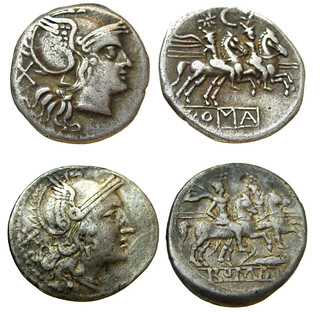 Despite its prior status as a luxury commodity, silver became widely used for coinage in the Roman world from the 7th century BCE onward and provided a standardized monetary system for ancient Mediterranean civilizations. However, the sources of silver used to produce Roman coinage have largely been used up, making it difficult to determine which deposits Roman miners exploited.
Despite its prior status as a luxury commodity, silver became widely used for coinage in the Roman world from the 7th century BCE onward and provided a standardized monetary system for ancient Mediterranean civilizations. However, the sources of silver used to produce Roman coinage have largely been used up, making it difficult to determine which deposits Roman miners exploited.
A new study published in the journal Geology yesterday evaluated silver sources from different mining provinces in the Iberian Peninsula to determine which locations may have been mined for silver to produce Roman coinage.
“The control of silver sources was a major geopolitical issue, and the identification of Roman silver sources may help archaeologists to reconstruct ancient fluxes of precious metals and to answer important historical questions, said Jean Milot, the lead author of this study.
The Iberian Peninsula, which includes modern Spain and Portugal, is host to world-class silver deposits, especially in the southern region. These deposits contain galena, which is the main ore of lead and an important source of silver. To extract silver, the galena ore is smelted and purified, with refined silver for coin minting able to reach a purity of over 95%.
To track the source of Roman silver, the team of researchers analyzed the silver and lead compositions of galena samples from ore deposits across the Iberian Peninsula and compared the results to the chemical signatures of silver Roman coins.
They identified two different types of galena deposits based on the silver elemental composition of the samples: silver-rich galena that would have been a likely source for Roman coinage, and silver-poor galena that would have been exploited for lead only and would have been of lower economic importance.
Found via The Explorator newsletter. To subscribe to Explorator, send a blank email message to: explorator+subscribe@groups.io. -Editor
To read the complete article, see:
Discovering sources of Roman silver coinage from the Iberian Peninsula
(https://www.geosociety.org/GSA/News/pr/2021/21-74.aspx)
THE COINS OF CHRIST
Stack's Bowers World and Ancient Coins Numismatist Nicholas Fritz published a blog article on the coins of Christ. -Editor
"Behold, you will conceive and give birth to a son, and you are to give Him the name Jesus." The words recorded in the Gospel of Luke 1:31 that herald the birth of Jesus form part of the famous nativity story often repeated at this time of year. The life of Jesus, a humble carpenter's son from Judea, has indelibly and inextricably changed the course of human history. It is easy to forget that he lived as a normal inhabitant of Judea, and this normalcy extended to his use of money, and the lessons he learned from interacting with it.
The province of Judea had fallen under Roman rule in the first century B.C. near the end of the Roman Republic. Under the reign of Herod the Great, from 44-6 B.C., Roman rule crystalized in Judea, from a somewhat tenuous grasp, to holding it firmly within the Roman world. This late absorption into the Roman Empire, coupled with the chafing of Jewish monotheism with Roman paganism, always made Roman Judea a less than peaceful environment. Under this Roman domination, Jesus was born. According to the Gospel of Matthew, it was during the reign of Herod, though it is unclear if it was the rule of Herod the Great or his son, Herod Antipas. Most scholars date the birth of Jesus to circa 7-2 B.C. Given the tumultuous political situation of first century A.D. Palestine, it is likely that Jesus interacted with several types of coinage throughout his life, a diversity reflected in the parables and stories Jesus told involving money. ?
The first time the gospels explicitly reference money is in the Gospel of Mark 12:13-17, when Jesus outsmarts the Pharisees by telling them to "pay unto Caesar that which is Caesar's and unto God that which is God's." The coin referenced in this parable was likely a silver Denarius of the emperor Tiberius, who held the Roman throne for nearly the entire adulthood of Jesus' life. Denarii were a standard medium of exchange in the Roman world, and it is unsurprising that they would have circulated widely. Such Denarii are highly attractive to collectors today for their biblical connection, with several being offered at our January 2022 New York auction. Leading this group is lot 3107, a magnificent NGC AU ? example.
In the same chapter of Mark, in verses 41-44, Jesus discusses the offering of a poor widow. Jesus considered the widow's offering of "two small copper coins worth less than a penny" as more than all the offerings of the rich, as she gave all she had. While the reference to the coins in this passage is less explicit, it was likely a bronze Mite or Lepton. These coins were struck earlier than the Roman period in most cases, and had the value of half a Quadrans, the lowest value Roman coin. These coins held very little value and could conduct only the paltriest of commercial transactions. The insignificance and banality of such a coin reinforced the principle of the parable in an especially powerful way to those who heard it firsthand. As with the tribute Denarius, these Mites have become quite collectible for their connection to Christ. A large grouping is offered in lot 6152 of our New York sale, one of many attractive large lots of ancients.
The final coin with a connection to Jesus is the Syrian Shekel of Tyre. Much preferred in commerce due to their purity and heft, these silver Tetradrachms were used to pay temple tax and facilitate commerce in the whole region. This ease of acceptance has led many to conclude that these are the most likely coins to have been thrown off the money changers' tables when Jesus overturned them at the temple. These Shekels also were the likely 30 pieces of silver given to Judas for his betrayal of Jesus. 30 Shekels was approximately equivalent to four months of wages for a skilled worker, making Judas' betrayal relatively cheap for the temple authorities who wanted to get rid of someone so disruptive of business. These Shekels, as with the other two biblical coins, have garnered a collector following. Numerous examples are offered at New York, including lot 4353, a NGC AU graded piece.
Jesus' interactions with money were somewhat typical for the average person living in Roman Judea. A large mixture of coins from different issuing authorities facilitated commerce in the Roman provincial areas, with a potpourri of Tyrian, Roman, and Roman Provincial issues being common. This shared experience allowed Jesus to construct parables and lessons around these objects and the desire to connect with this heritage has driven much interest in these coins.
These coins will be featured in our January 2022 Official Auction of the NYINC as part of an exceptional offering of Ancient coins as well as important World coins and paper money. The entire sale is available for viewing and bidding at StacksBowers.com, where you can also see our upcoming auction schedule and future offerings.
To read the complete article, see:
Coins of Christ
(https://www.stacksbowers.com/News/Pages/Blogs.aspx?ArticleID=the-coins-of-christ)
JERSEY COIN HOARD SOLD
The world's largest ever hoard of Iron Age coins has been bought by the island of Jersey. -Editor
The world's largest ever hoard of Iron Age coins has been bought from the Queen by the island of Jersey for £4 million using funds retrieved from criminals.
The Le Câtillon II hoard containing nearly 70,000 Celtic coins was discovered on Jersey in 2012 by two amateur metal detectorists who had spent three decades combing a single field.
The two friends, Reg Mead and Richard Miles, initially received a tip-off in the 1980s from a woman who said she had spotted something that looked like silver buttons.
They eventually came across a clump of coins so large that they immediately called Jersey Heritage, the professional museum body on the island.
The 69,347 coins were found under a hedge in a mound of clay...
Found via The Explorator newsletter. To subscribe to Explorator, send a blank email message to: explorator+subscribe@groups.io. -Editor
To read the complete article, see:
Jersey coin hoard found by metal detectors is sold for £4m
(https://www.thetimes.co.uk/article/jersey-coin-hoard-found-by-metal-detectors-is-sold-for-4m-hbsg8c2v6)
ISRAELI ARCHAEOLOGISTS EXPLORE SHIPWRECK SITE
Arthur Shippee passed along this Washington Post article about a recent shipwreck find off the coast of Israel. Thanks. -Editor
Hundreds of rare antiquities were discovered off the Mediterranean coast of Israel, archaeologists there said Wednesday.
The Israel Antiquities Authority said the artifacts were found in recent months as its Marine Archaeology Unit explored the remains of two ships that sank roughly 1,700 and 600 years ago off the coast of Caesarea. The shipwreck remains were found scattered on the sea floor in shallow water.
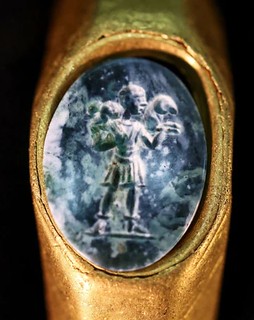 In a statement posted on the Israeli Foreign Ministry's website, the IAA highlighted some of the findings from the search, including coins, bells, gemstones and figurines from the third-century Roman and 14th-century Mameluke periods — and a gold ring the authority said bore an image of the
In a statement posted on the Israeli Foreign Ministry's website, the IAA highlighted some of the findings from the search, including coins, bells, gemstones and figurines from the third-century Roman and 14th-century Mameluke periods — and a gold ring the authority said bore an image of thegood shepherd
that was used by early Christians to symbolize Jesus.
The search uncoveredhundreds of silver and bronze Roman coins from the mid-third century CE,
the release said, as well as about 560silver coins from the Mamluk period.
To read the complete article, see:
Israeli archaeologists find hundreds of precious antiquities in shipwrecks
(https://www.washingtonpost.com/world/2021/12/23/israel-antiquities-shipwreck-caesarea/)
PLATFORM TICKETS
Earlier this month Yosef Sa'ar forwarded these images and asked, "Have you ever heard of platform tokens?" I hadn't, and he kindly provided some additional information per Wikipedia. -Editor
A platform ticket is a type of rail ticket issued by some railway systems, permitting the bearer to access the platforms of a railway station, but not to board and use any train services. It allows people to walk with their friends, associates and loved ones all the way to the passenger car at stations where the general public is not admitted to platforms. Trainspotters can also purchase platform tickets and enjoy their trainspotting hobbies.[1] They vary in type: some may only allow limited access and a sharply limited time of usage, while others may have totally free access to enter the platform area. During peak usage hours or rush hours, the platforms may only be available for passengers who intend to travel.
Platform tickets emerged in the 19th century. At that time passenger coaches had no internal corridor, as they have today. In order to inspect tickets, conductors had to move along the outside of the train while it was in motion. Although trains moved much slower than today, there were numerous accidents. Therefore, railway operators began to check the tickets on the platform before passengers boarded the train. Passing these checkpoints required either a ticket for travel or the platform ticket, which was only valid for access to the platform. After railcars were changed, people and conductors could move from carriage to carriage so checking the tickets outside the train was no longer necessary. Most railway transport systems abolished this in the second half of the 20th century. As soon as there were no more checks, the platform ticket was unnecessary and generally was abandoned. However, as there are now automated ticket barriers, railfans and trainspotters buy these tickets to get past the barriers and onto the platform
Yosef adds:
"In Serbia several bus and at least one rail station platform tokens were used. Same usage as platform tickets in the Wikipedia description above. The images are of tokens listed in the Ranko Mandic book, "Token Catalog of the Countries of Former Yugoslavia".
"If you are into Harry Potter, I suppose this is also a platform token. My daughter says Platform 9-3/4 is where you board the Hogwarts Express, the train Harry takes to Hogwarts School. Have a scary ride."
For all your Harry Potter Platform 9-3/4 merch, see:
https://harrypottershop.co.uk/collections/platform-9-3-4
To read the complete article, see:
Platform ticket
(https://en.wikipedia.org/wiki/Platform_ticket)
LEALANA BITCOIN SET OFFERED
Stacks Bowers Director of Consignments and Numismatics James McCartney published a blog article about the firm's upcoming sale of a set of silver 2013 Lealana physical bitcoins. -Editor
We are excited to feature a scarce four-coin set of silver 2013 Lealana physical bitcoins in our Spring 2022 Showcase Auction. Struck in .999 fine silver and graded by PCGS, this set offers incredible rarity and exceptional condition. Each coin is marked with the serial number 24, making it one of the earliest sets issued by Lealana creator Noah Luis, aka "smoothie."
The coins from this set remain "loaded" and unpeeled and will be offered individually in consecutive lots, though an advanced collector could potentially acquire all four coins and keep the set intact. The set includes a 0.1 BTC graded Proof-70 Deep Cameo, a 0.25 BTC graded Proof-69 Deep Cameo, a 0.5 BTC graded Proof-70 Deep Cameo, and an important gold-plated 1 BTC graded Proof-69 Deep Cameo. The last is described by specialist Elias Ahonen as "perhaps the most visually interesting" issue from this series in his Encyclopedia of Physical Bitcoins and other Crypto-Currencies. The coins are accompanied by the original certificates of authenticity.
With a rising number of these coins being peeled and redeemed for their intrinsic bitcoin value, unpeeled and "loaded" physical cryptocurrency has become increasingly scarce and often command significant premiums above their intrinsic "face value." Unredeemed four-coin sets with matching serial numbers like the present group are even more elusive. With a nearly 500% premium realized by the SP-70 (PCGS) Lealana 0.1 Bitcoin in our November 2021 sale, enthusiasm among aficionados of cryptocurrency and traditional numismatists is evidently strong for this new and exciting category.
This desirable Lealana bitcoin set will be offered alongside a remarkable selection of physical cryptocurrency in our Spring 2022 Showcase Auction, including several brass 2011 Casascius 1 BTC coins and a scarce three-coin Lealana litecoin (LTC) set.
To read the complete article, see:
Exciting Lealana Bitcoin Set Featured in our Spring 2022 Showcase Auction
(https://www.stacksbowers.com/News/Pages/Blogs.aspx?ArticleID=physical-bitcoins-stacks-bowers-galleries-march-2022-auctions)
To read the earlier E-Sylum article, see:
NEW BOOK: ENCYCLOPEDIA OF PHYSICAL BITCOINS
(https://www.coinbooks.org/v24/esylum_v24n45a05.html)
THE BOOK BAZARRE
JUDAICA ART MEDAL AWARDS ANNOUNCED
Two medalists received the Mel Wacks Judaica Art Medal Award at the Tokyo FIDEM. Here's the press release. -Editor
Mel Wacks Judaica Art Medal Award Announced at FIDEM Tokyo 2020/2021
 At FIDEM Tokyo 2020/2021, the biennial Congress of the International Art Medal Federation, two medalists were chosen to share the Mel Wacks Judaica Art Medal Award, for Judaic, Biblical or Holy Land themes - Ewa Olszewska-Borys of Poland and Romualdas Incirauskas of Lithuania. Each will receive an engraved silver medal, courtesy of the Jewish-American Hall of Fame, and will share the $250 prize money, presented by the Cincinnati Skirball Museum, home of the Jewish-American Hall of Fame Medal Collection. Wacks founded the Jewish-American Hall of Fame in 1969, and has served as its director since then.
At FIDEM Tokyo 2020/2021, the biennial Congress of the International Art Medal Federation, two medalists were chosen to share the Mel Wacks Judaica Art Medal Award, for Judaic, Biblical or Holy Land themes - Ewa Olszewska-Borys of Poland and Romualdas Incirauskas of Lithuania. Each will receive an engraved silver medal, courtesy of the Jewish-American Hall of Fame, and will share the $250 prize money, presented by the Cincinnati Skirball Museum, home of the Jewish-American Hall of Fame Medal Collection. Wacks founded the Jewish-American Hall of Fame in 1969, and has served as its director since then.
Ewa Olszewska-Borys' medal, titled E=mc², is described in the catalog as:Albert Einstein predicted gravity waves first observed in 2015. The reverse of the medal shows the fusion of two black holes and the gravity waves this generates.
The large (127 x 130 mm) rectangular cast bronze medal features a thoughtful Einstein in Ewa's dramatic personal style combining incused and raised surfaces.
The other winning medal, by Romualdas Incirauskas, portrays Chiune Sugihara. It is also rectangular, measuring 150 x 150 mm, and described in the catalog as:Dedicated to Japanese diplomat Chiune Sugihara (1900-1986), who lived in Lithuania, in Kaunas, from 1939-1940. During World War II, he saved about 6,000 Jews from Lithuania, Poland and Germany by issuing them with Japanese transit visas. The medal is dedicated to [his] 120th birth anniversary. The symbols on the reverse convey the tragedy of the Jewish people.
The reverse depicts a large Star of David intertwined with scenes of Jewish victims behind barbed wire fences of the death camps, with inscriptions:6000 lives
and a quote from Matthew 5:6-10, ending withBlessed are they which are persecuted for righteousness sake: for theirs is the kingdom of heaven.
Collectors can contact these medalists for availability and pricing information at eob@wp.pl and incirauskas@gmail.com. For further information about the Jewish-American Hall of Fame, visit www.amuseum.org/jahf.
WEYBURN SECURITY BANK NOTES
George Manz submitted this article about banknotes of the Weyburn Security Bank to be displayed at the 2022 Spring Regina Coin Show. Thank you. -Editor
The Weyburn Security Bank and its Rare Banknotes
By George Manz, FRCNA
In the early 1880s, the Canadian Pacific Railway began to bring settlers into southern Saskatchewan to farm the prairie landscape. The village of Weyburn was founded in 1899.
The Weyburn Security Company was formed in Weyburn in 1902 by a small group of American settlers from South Dakota and Minnesota. They purchased 50,000 acres of land with the aim to settle southeastern Saskatchewan.
They soon realized for their real estate, private banking, insurance, and lumber business to succeed, they needed to set up a chartered bank. So, in 1910, they petitioned the Canadian Parliament for a charter to incorporate as The Weyburn Security Bank.
On January 1, 1911, the Weyburn Security Bank opened for business with $1 Million in capital and branches in nine southern Saskatchewan rural towns and villages.
In 1924, the Weyburn Security Bank had branches in 27 different towns and villages as well as Weyburn. For more than 20 years, the small bank had to compete with much larger Canadian chartered banks.
Initially, the Weyburn Security Bank prospered by providing banking and other services to its mainly farming clientele.
Unfortunately, the Great Depression resulted in three successive crop failures. So, the Weyburn Security Bank had discussions with the Imperial Bank of Canada, which until then did not have any bank branches south of the mail line of the Canadian Pacific Railway.
In 1931, the Weyburn Security Bank ceased to exist after it merged with the Imperial Bank of Canada.
The Imperial Bank of Canada continued until 1961, when it amalgamated with the Canadian Bank of Commerce to become the Canadian Imperial Bank of Commerce (CIBC).
The best history of the Weyburn Security Bank is Cecil Tannahill's ground-breaking book Saskatchewan Trade Tokens, Paper Money Scrip. In it, Tannahill writes,
“When the Weyburn Security Company made application for the charter they also made application for the issuance of bank notes and the dating of the notes was timed to fit in with the commencement of business as a chartered bank. The order for the notes was placed with the American Bank Note Company, Ottawa, and notes dated January 3rd, 1911 were issued in denominations of $5.00, $10.00 and $20.00. The newly printed notes were shipped to the Head Office in Weyburn and were sent out to the various branches on requisition by the branch Managers. The requisition was to specify how many notes of each denomination were required and it was to be taken into consideration that the $5.00 and $10.00 notes would be shipped from Head Office in sheets of four (4) and the $20.00 notes in sheets of two (2). The notes were to be cut by the Manager of the receiving bank and who was also responsible for the countersigning of the notes before they were placed in circulation. The Manager was required to gather in all soiled and mutilated notes and have them ready to send into Head Office when requested to do so. It was quite apparent that the officers of the Weyburn Security Bank wanted new notes available in each branch at all times and they appeared quite particular as to the condition of other notes being used. Their notes were very acceptable to the people of the region and it appears that 1925 was the peak year of circulation as records show $858,910.00 as notes outstanding.
And what notes they are! The face of the $5 note depicts a train in a city, while the $10 note portrays allegorical women and children. The $20 note has the portrait of a woman in an oval frame supported by two cherubs.
Tannahill writes,All soiled and mutilated notes when returned to Head Office were held until the next Director's meeting, at which time 3 Directors would count and burn the notes and the amount duly recorded.
The reason why Weyburn Security Bank notes are so rare is because the WSB officials cared about the appearance of the notes and then burned the vast majority of them. The 9th Edition of Charlton Standard Catalogue Canadian Bank Notes lists only 50 notes known to exist with nine of them in institutional collections.
The Regina Coin Show will display four issued Weyburn Security Bank notes at its 2022 Spring Show and Sale. As well, five Proof Weyburn Security Bank notes will accompany the display.
The show takes place on April 23-24, 2022 at a new venue: The Italian Club, 2148 Connaught Street in Regina.
George Manz is President of the Regina Coin Club and Fellow of the Royal Canadian Numismatic Association.
For more information on the Regina Coin Club, see:
https://www.reginacoinclub.ca/
THE IMPORTANCE OF NUMISMATICS
Earlier this month Samuel Vargas Rodríguez published a nicely illustrated article on the Tauler Fau blog about the Importance of Numismatics. -Editor
Numismatics is the science studying the coins and the objects connected with them. It is an auxiliary branch of archaeology. In fact, in the academic world numismatics and epigraphy – the discipline decoding the inscriptions found on a solid base, such as the metal and stone in tombstones and monuments, – are often part of the same subject. As a result, numismatics is a supporting science, which is essential to get to know and complement effectively the archaeological studies, or the history of ancient civilizations. Thanks to the coins and other objects, it is possible to determine the age of the archaeological sites with little margin of error.
In order to understand the trade and economy, as well as the often-forgotten daily life and people of ancient times, we must start with a thorough study of the coin. This explains the importance of numismatics, which provides us with very useful information. The study of the characteristics of the coin, such as the quantity and quality, the state of preservation, the weight, the metal used in order to produce it, the iconography, or the place where it was found… gives us a lot of information about the people who produced it. The finding of coins far from the place of production gives us key data to value the mobility, efficiency and the trade capability of the human groups. I would also like to mention that the finding of larger or smaller sets of coins forming a treasure or concealment tells us about the context in which they might have been produced – invasions, social and political crisis, thefts or smuggling...
Treasure of Gazteluberri (Segura, Guipúzcoa) consisting of 52 golden and silver coins of Joanna I, Charles V and Philip II. (1537-1598). Displayed at the National Archaeological Museum of Madrid. This treasure was hidden in a cowbell, which had been buried in the mountains, far away from any town, at the end of the 16th century or beginning of the 17th century. It was probably the savings of some farmer or some smuggler's booty. Coins were practical and easily manipulated, they were meant to circulate and were used by everyone everywhere. Besides, everyone trusted them, as they had the seal or mark of the authority producing them. Coins were highly regarded, not only because of their acceptance – in some cases, they were wanted at global level at their own time, as it happened with the Roman denarius or the piece of eight of the Spanish Empire, – but also because they were a very efficient way to accumulate a fortune, due to their characteristics and durability. We must also bear in mind that the armies were paid with coins (mostly silver coins), so until recently the money in the form of coins played a very significant role in the society.
Silver piece of eightPillar Dollar
, produced in 1770, mint of Potosí, under the name of Charles III
To read the complete article, see:
The Importance of Numismatics
(https://www.tauleryfau.com/blog/en/the-importance-of-numismatics/)
WHICH CAME FIRST: DEBT OR MONEY?
A Coin Update article by Dennis Tucker discusses references to coinage in a book about cities. Here's an excerpt - see the complete article online. Which Came First: Debt or Money? -Editor
 The other day I was reading Monica L. Smith's Cities: The First 6,000 Years. Dr. Smith is a professor in the Department of Anthropology at UCLA, and director of the South Asian Archaeology Laboratory at the university's Cotsen Institute of Archaeology. Her book is, as Science magazine puts it,
The other day I was reading Monica L. Smith's Cities: The First 6,000 Years. Dr. Smith is a professor in the Department of Anthropology at UCLA, and director of the South Asian Archaeology Laboratory at the university's Cotsen Institute of Archaeology. Her book is, as Science magazine puts it,a compelling journey from city life in ancient urban centers to the present and beyond.
In a section titledWhere Did All the Money Go?
Smith delves into the history of economics.We might think that coinage came first and that abstract debt instruments such as bills of lading and credits cards and bank loans came later,
she writes.But it's actually the reverse, because the idea of debt and repayment was in existence long before the development of coined money.
Reciprocity, at first sealed with words and a handshake, later was put down in writing and then in durable physical symbols of value, such as coins and paper currency.
Smith discusses the development of cash in Europe and Asia, its spread throughout networks of urbanism (like ports and trade routes), its use in commerce, its propaganda value, and other aspects of coins in particular. She lays out some interesting ways coins made new opportunities not just for merchants and priests, for example, but also for beggars, with panhandling asa job option and economic niche within the urban realm.
She describes coinage as revolutionary—After it was invented, it became a concept and a substance that people couldn't live without, like writing, clocks, and, as we can now add, broadband internet.
It was delightful to find this exploration of coins in an otherwise non-numismatic book.
To read the complete article, see:
Notes Published: Finding coins in a book about cities
(https://news.coinupdate.com/notes-published-finding-coins-in-a-book-about-cities/)
NEW BOOK: THE PRIVATE LIBRARY
To a bibliophile, life wouldn't be quite worth living without books. This New York Times article mentions a new book on the history of the private library. Here's an excerpt - see the complete article online. -Editor
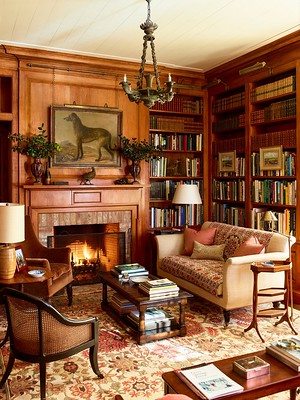 At the turn of the millennium, Reid Byers, a computer systems architect, set out to build a private library at his home in Princeton, N.J. Finding few books on library architecture that were not centuries old and in a dead or mildewed language, he took the advice of a neighbor across the street, the novelist Toni Morrison.
At the turn of the millennium, Reid Byers, a computer systems architect, set out to build a private library at his home in Princeton, N.J. Finding few books on library architecture that were not centuries old and in a dead or mildewed language, he took the advice of a neighbor across the street, the novelist Toni Morrison.
Ms. Morrisononce famously said if there is a book you want to read and it doesn't exist, then you must write it,
recalled Mr. Byers, 74, in a video chat from his current home, in Portland, Maine.
The project stretched over a generation and culminated this year in a profusely illustrated, detail-crammed, Latin-strewn and yet remarkably unstuffy book calledThe Private Library: The History of the Architecture and Furnishing of the Domestic Bookroom,
published by Oak Knoll Press.
The opus arrives at an ambivalent time for book owners. As the pandemic's social and economic disruptions have nudged people into new homes, some are questioning whether it is worth dragging along their collections. Given the inflated costs of real estate and the capacity of e-readers to hold thousands of titles, maybe that precious floor and wall space could be put to other uses?
And yet there are clear benefits in a pandemic to having a private sanctuary programmed for escapism.
“The tactile connection to books and the need for places of refuge in the home, both for work and for personal well-being, have made libraries a renewed focus in residential design, said Andrew Cogar, the president of Historical Concepts, an architecture firm with offices in Atlanta and New York.
Morgan Munsey, who sells real estate for Compass in Brooklyn and Manhattan, has seen well-groomed libraries in brownstones help spark bidding wars.
InThe Private Library,
Mr. Byers goes to the heart of why physical books continue to beguile us. Individually, they are frequently useful or delightful, but it is when books are displayed en masse that they really work wonders. Covering the walls of a room, piled up to the ceiling and exuding the breath of generations, they nourish the senses, slay boredom and relieve distress.
“Entering our library should feel like easing into a hot tub, strolling into a magic store, emerging into the orchestra pit, or entering a chamber of curiosities, the club, the circus, our cabin on an outbound yacht, the house of an old friend, he writes.It is a setting forth, and it is a coming back to center.
Having begun 4,000 years ago, asstrange little rooms in modest Mesopotamian houses
storing cuneiform tablets, libraries reached their Western European apotheosis by the 18th and 19th centuries as grand paneled spaces with fireplaces, ornate ceilings, built-in shelves, hard and soft chairs (for serious and relaxed reading), plush carpets, game tables, maybe a grand piano and secret doors (through which servants discreetly entered to tend fires).
To read the complete article, see:
How Many Books Does It Take to Make a Place Feel Like Home?
(https://www.nytimes.com/2021/12/24/realestate/why-do-people-keep-books.html)
LOOSE CHANGE: DECEMBER 26, 2021
Here are some additional items in the media this week that may be of interest. -Editor
John and Nancy Wilson passed along this New-York Historical Society article about the New York City Origins of Santa Claus. Thanks. -Editor
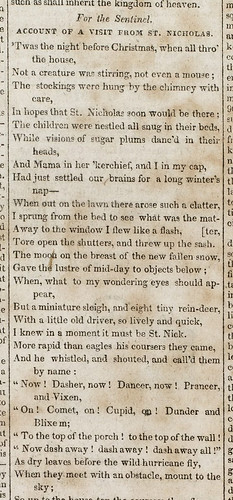 Anyone who knows about Jolly Old St. Nick will tell you that he and Mrs. Claus's lifelong home is at the North Pole…and we're here to tell you otherwise! Sorry, friends. The Santa you know and love today is actually from New York City! Or at least the image of Santa that has become commonplace today was invented by a few prominent 19th-century New Yorkers: Clement Clarke Moore, Washington Irving, and Thomas Nast.
Anyone who knows about Jolly Old St. Nick will tell you that he and Mrs. Claus's lifelong home is at the North Pole…and we're here to tell you otherwise! Sorry, friends. The Santa you know and love today is actually from New York City! Or at least the image of Santa that has become commonplace today was invented by a few prominent 19th-century New Yorkers: Clement Clarke Moore, Washington Irving, and Thomas Nast.
Of course, some notion of Santa existed before the 19th century. Our Christmas elf is based on the real historical figure of St. Nicholas of Myra (or Bari), a man who died on December 6, 343 CE, in modern day Turkey. He was said to have performed many good deeds and miracles in his life. One good deed was secretly giving bags of gold to a family whose three daughters needed dowries to be saved from a life of poverty, and one miracle was a ghastly tale of Nicholas resurrecting three murdered children. Therein lie the origins of associating St. Nick with gift giving and kindness to kids.
Today, Nicholas is revered in the Catholic faith as the patron saint—kind of like a protector—of sailors, merchants, archers, repentant thieves, children, brewers, pawnbrokers, and students. St. Nick is particularly celebrated in the Netherlands, where a holiday called Sinterklaas happens annually on December 5 or 6. Worldwide, many Catholics celebrate St. Nick's Feast Day on December 6—the day he died.
The Dutch brought their devotion to St. Nicholas with them to the places they colonized, including New Amsterdam. New Yorkers of Dutch and other heritages grew up in the late 17th and early 18th centuries celebrating some form of Sinterklaas, or seeing others do so. Many revolutionary-minded New Yorkers developed an interest in Dutch culture because of a distaste for the British after the U.S. gained its independence.
To read the complete article, see:
The New York City Origins of Santa Claus
(https://historydetectives.nyhistory.org/2018/12/the-new-york-city-origins-of-santa-claus/)
Allen Schein passed along this article with the latest news on the Rust Rare Coin Ponzi scheme scandal. Thanks. -Editor
The Utah man who prosecutors and investors have accused of running a $200 million silver trading scheme to fund charitable causes and lure more victims, pleaded guilty in federal court Monday.
Gaylen D. Rust, 62, pleaded guilty to wire fraud, securities fraud and money laundering conspiracy. The plea agreement calls for prosecutors to recommend 19 years in prison.
Rust and his family operated Rust Rare Coin. According to civil and criminal court documents, beginning in at least 2008, Rust induced investors to put money toward silver trading.
“Their money was going to be used to buy physical silver that was going to be stored at the warehouse, explained Alan Rosca, an attorney representing some of Rust's investors.
“And it turned out that none of that was true, Rosca said. "He was a fraud. It was all smoke and mirrors.
To read the complete article, see:
Gaylen Rust, Utahn accused of $200 million Ponzi scheme, pleads guilty
(https://www.fox13now.com/news/local-news/gaylen-rust-utahn-accused-of-200-million-ponzi-scheme-pleads-guilty)
Chinese Banknote Printing Mischief?
Kavan Ratnatunga writes:
 "On Dec. 8th, 2021, the deputy general manager of the China Banknote Printing and Minting Corporation and a director of the company was reportedly investigated on suspicion of "serious violations of the law and party discipline."
"On Dec. 8th, 2021, the deputy general manager of the China Banknote Printing and Minting Corporation and a director of the company was reportedly investigated on suspicion of "serious violations of the law and party discipline."
"This has become a hot search online in mainland China. Chinese people are wondering: What mistake the printer of Renminbi has made? According to an overseas tweet, "The trillions of counterfeit bills in the Chinese market are authentic, printed by the China Banknote Printing Corporation. Everything is real, including serial numbers.“
"If the Chinese Banknote Printing and Minting Corporation had actually printed duplicate bills, I wonder if such news would scare the money printing clients? However, based on the CCP's habit of covering up real information, we don't expect to get a definitive answer to the question of whether there are duplicate authentic bills in China."
Thanks. Kavan passed along a link to a YouTube video on the topic. If this happened it was an inside job, but is very reminiscent of the true story of The Man Who Stole Portugal - Alves Reis, a con man who forged documents and impersonated state officials to trick a banknote printing firm into printing a batch of real banknotes. -Editor
To watch the complete video, see:
How the duplicate banknotes would impact the Chinese financial system/The new level of corruption?
(https://www.youtube.com/watch?v=jmgBpRAB8B4&t=10s)
For more information, see:
China Denies Detained Mint Banker Forged $314 Billion of ...
(https://www.bloomberg.com/news/articles/2021-12-22/china-denies-detained-mint-banker-forged-314-billion-of-notes)
To read earlier E-Sylum articles, see:
ALVES REIS: THE MAN WHO STOLE PORTUGAL
(https://www.coinbooks.org/esylum_v18n29a32.html)
1922 BANK OF PORTUGAL 500 ESCUDOS NOTE
(https://www.coinbooks.org/v24/esylum_v24n18a33.html)
FEATURED WEB SITE: BUFFALO NUMISMATIC ASSOCIATION
This week's Featured Web Site is the Buffalo Numismatic Association.
Since 1927, The Buffalo Numismatic Association (The BNA) has been dedicated to promoting the hobby of coin and money collecting. Membership is open to anybody that is interested in promoting, learning or supporting the hobby of numismatics. The club encourages fellowship among member collectors and dealers. The BNA holds monthly meetings, monthly coin shows, a fall convention and a major spring coin show where dealers, members and the public can buy, sell and trade coins, bills, tokens and related numismatic items.
The Buffalo Numismatic Association is a non-profit organization that is also is dedicated to serving the community of Western New York. Through partnerships with other area coin clubs, The BNA has supported various numismatic related activities and partnered with the local Boy Scouts and Girl Scouts to host Coin Collecting Merit Badge Workshops.








